Abstract
Behavior is treated as basic physics. Dimensions are identified and their transformations from physical specification to axes in behavioral space are suggested. Responses are treated as action patterns arrayed along a continuum of activation energy. Behavior is seen as movement along a trajectory through this behavior space. Incentives or reinforcers are attractors in behavior space, at the centers of basins of lowered potential. Trajectories impinging on such basins may be captured; repeated capture will warp the trajectory toward a geodesic, a process called conditioning. Conditioning is enhanced by contiguity, the proximity between the measured behavior and the incentive at the end of the trajectory, and by contingency, the depth of the trajectory below the average level of the potential energy landscape. Motivation is seen as the potential of an organism for motion under the forces impinging on it. Degree of motivation is characterized by the depth of the potential field, with low motivation corresponding to a flat field and a flat gradient of activation energy. Drives are the forces of incentives propagated through behavior space. Different laws for the attenuation of drive with behavioral distance are discussed, as is the dynamics of action. The basic postulate of behavior mechanics is incentive-tracking in behavior space, the energy for which is provided by decreases in potential. The relation of temporal gradients to response differentiation and temporal discrimination is analyzed. Various two-body problems are sketched to illustrate the application of these ideas to association, choice, scalar timing, self-control, and freedom.
Full text
PDF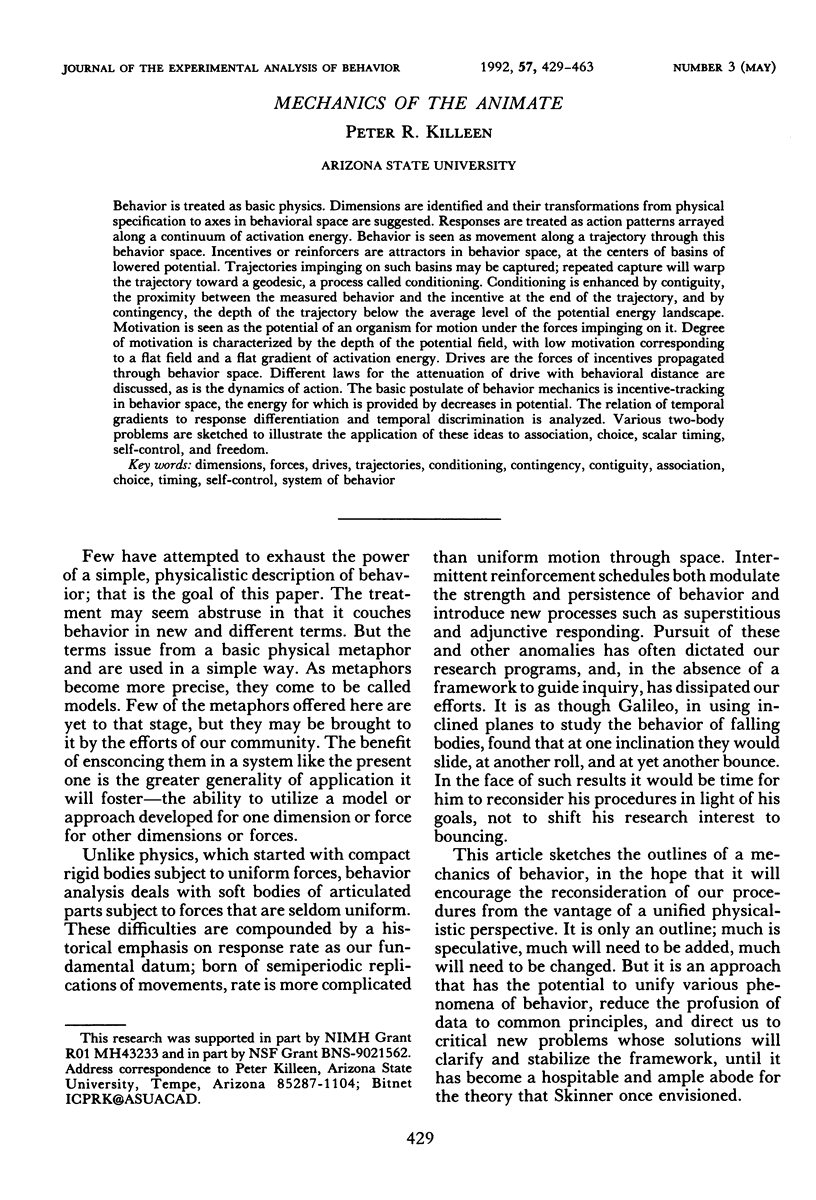
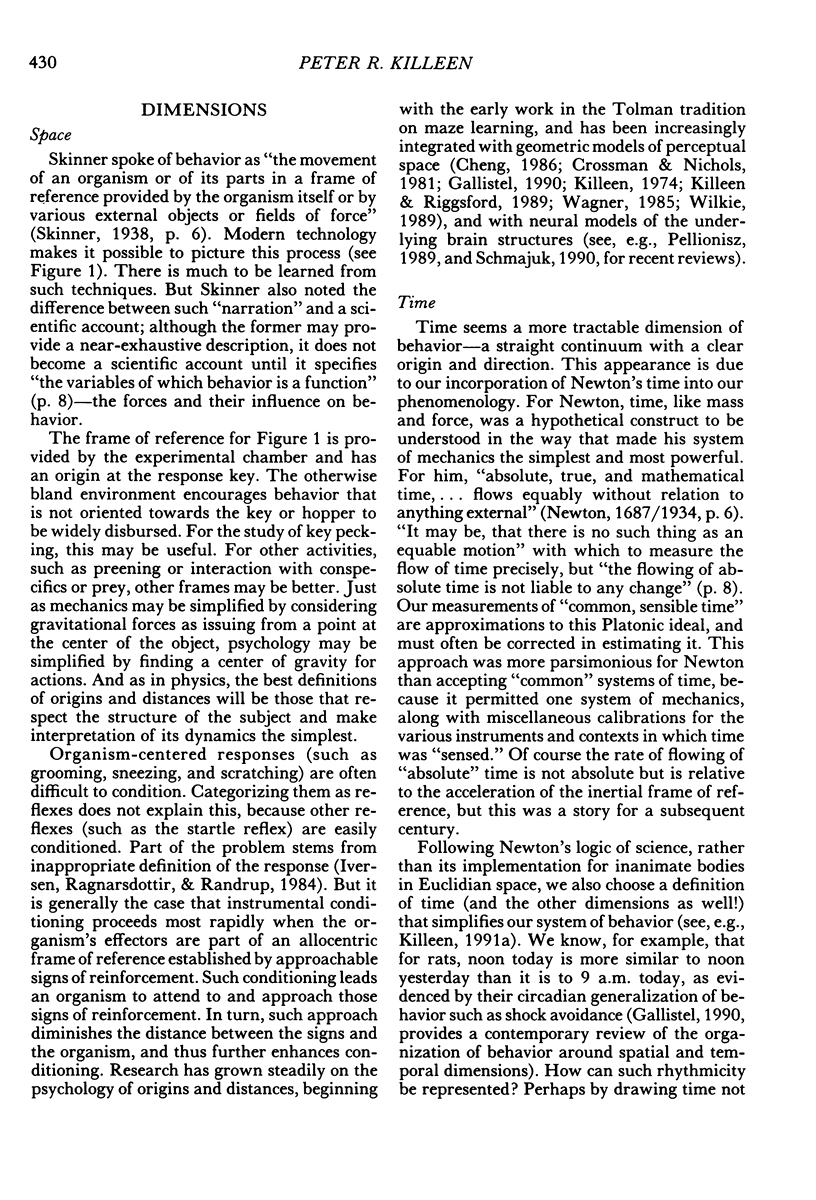

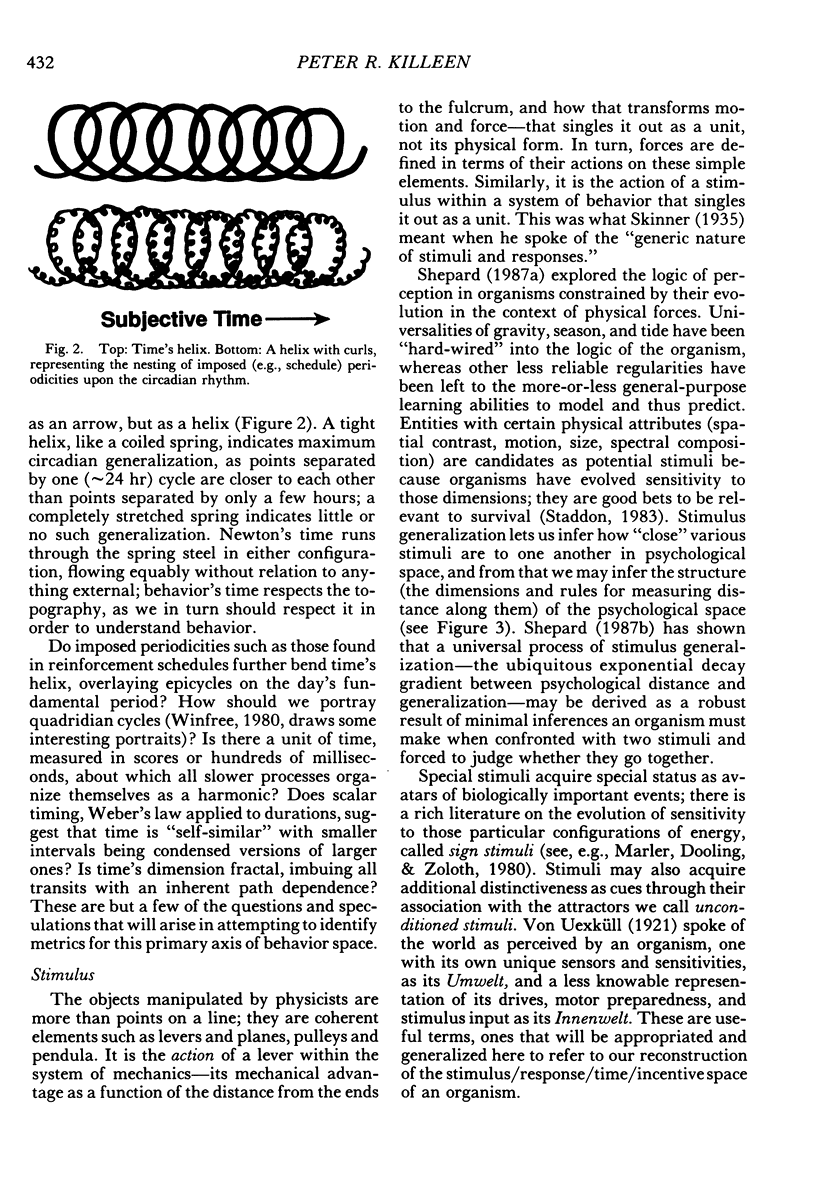
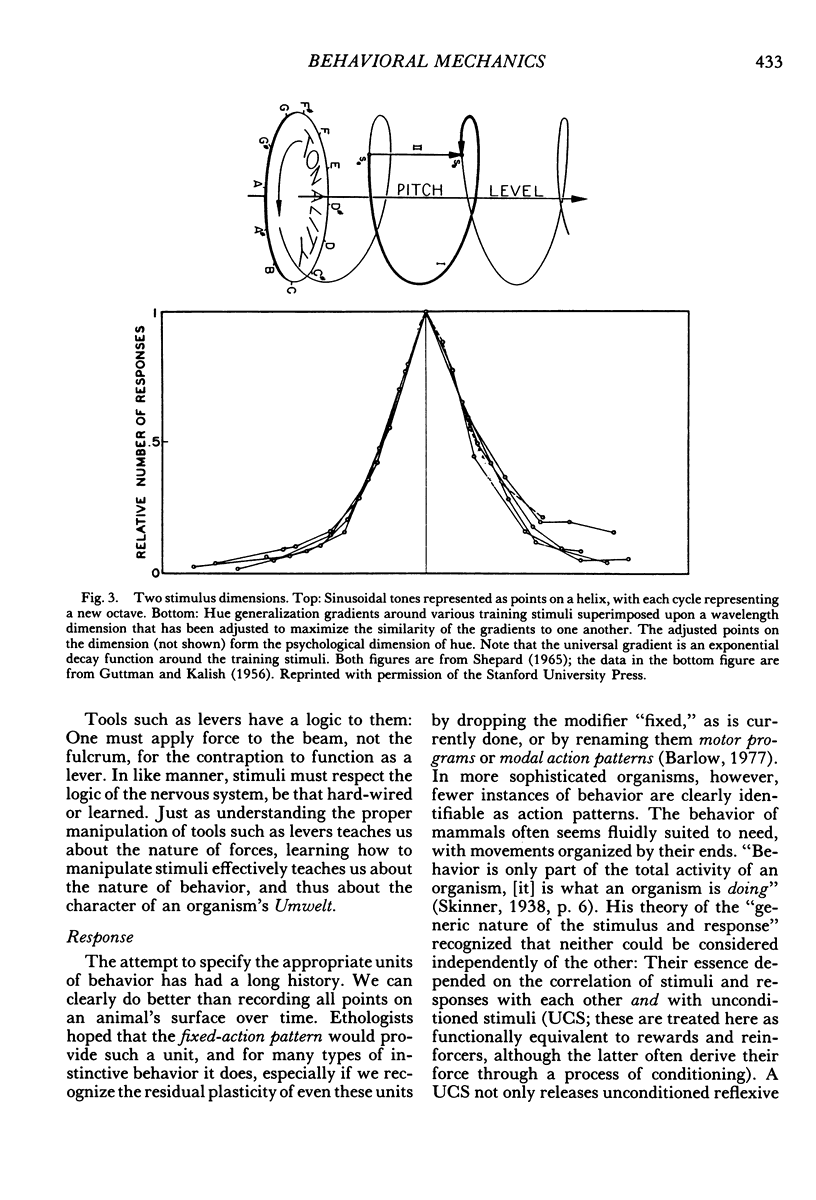
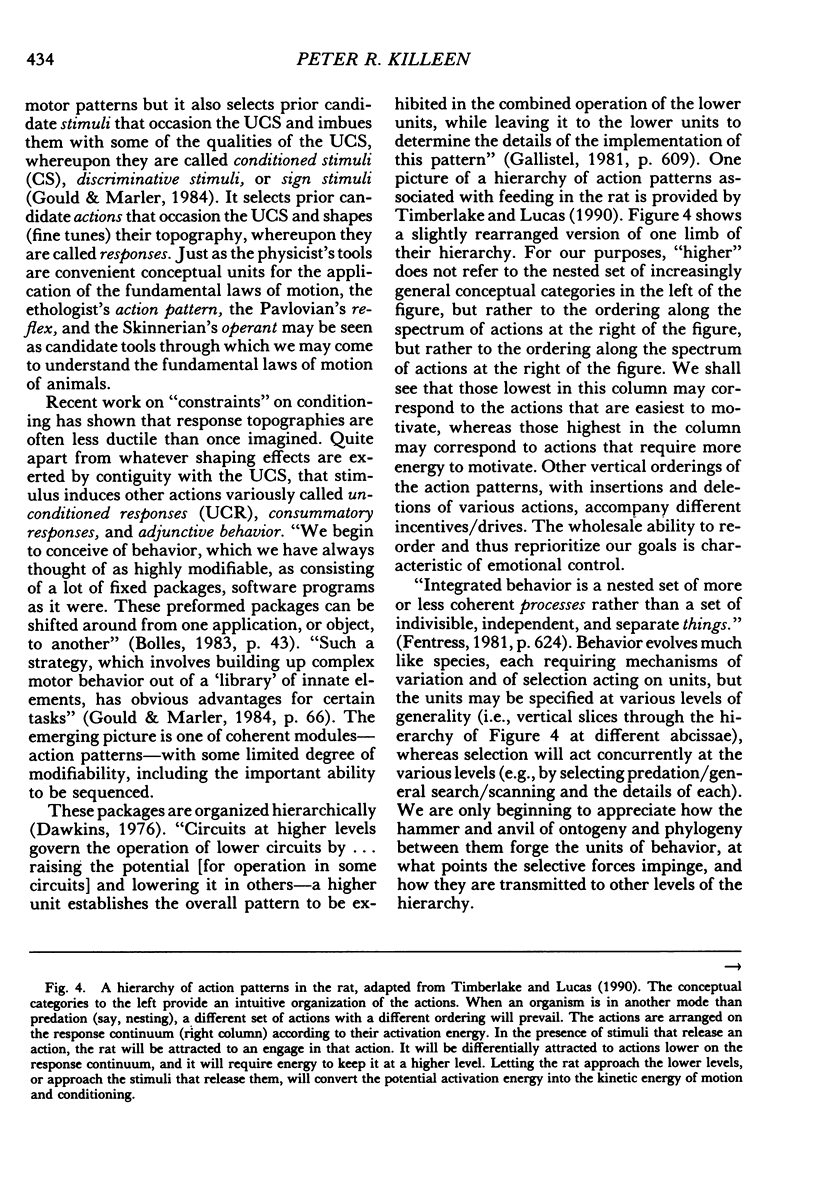
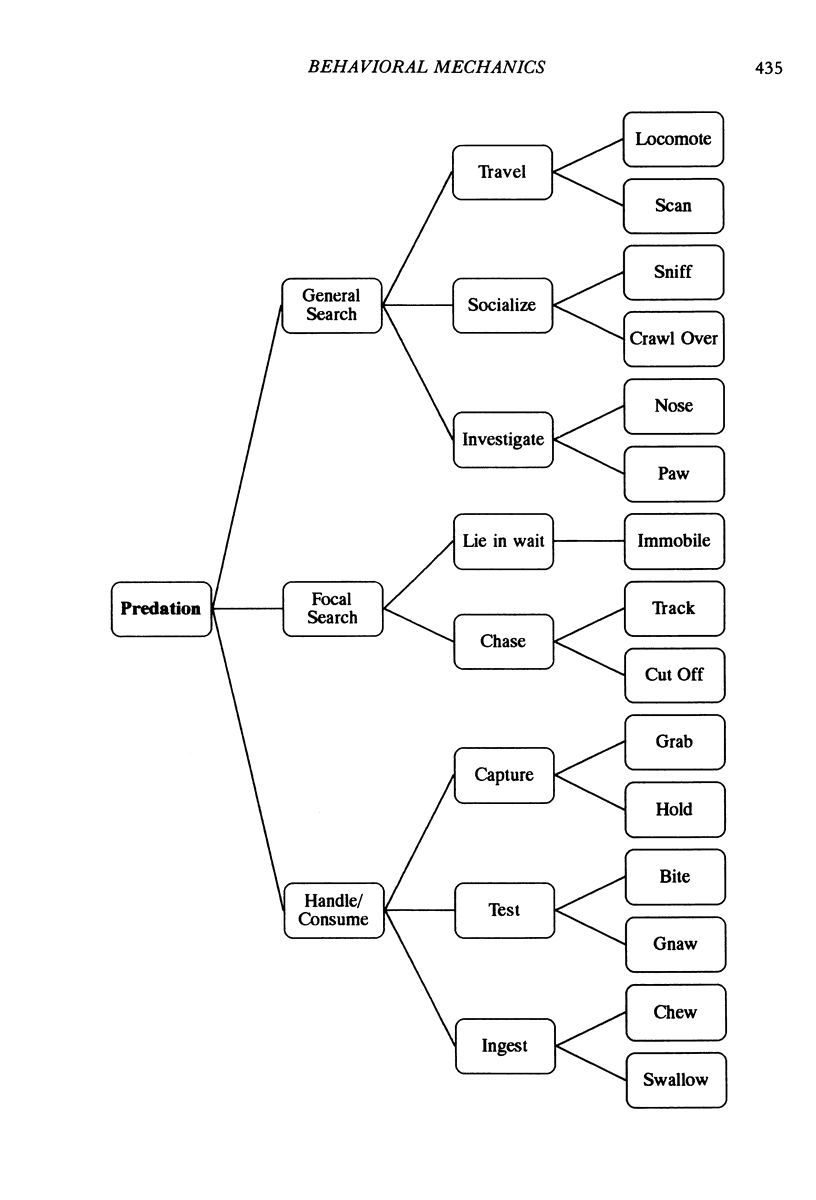
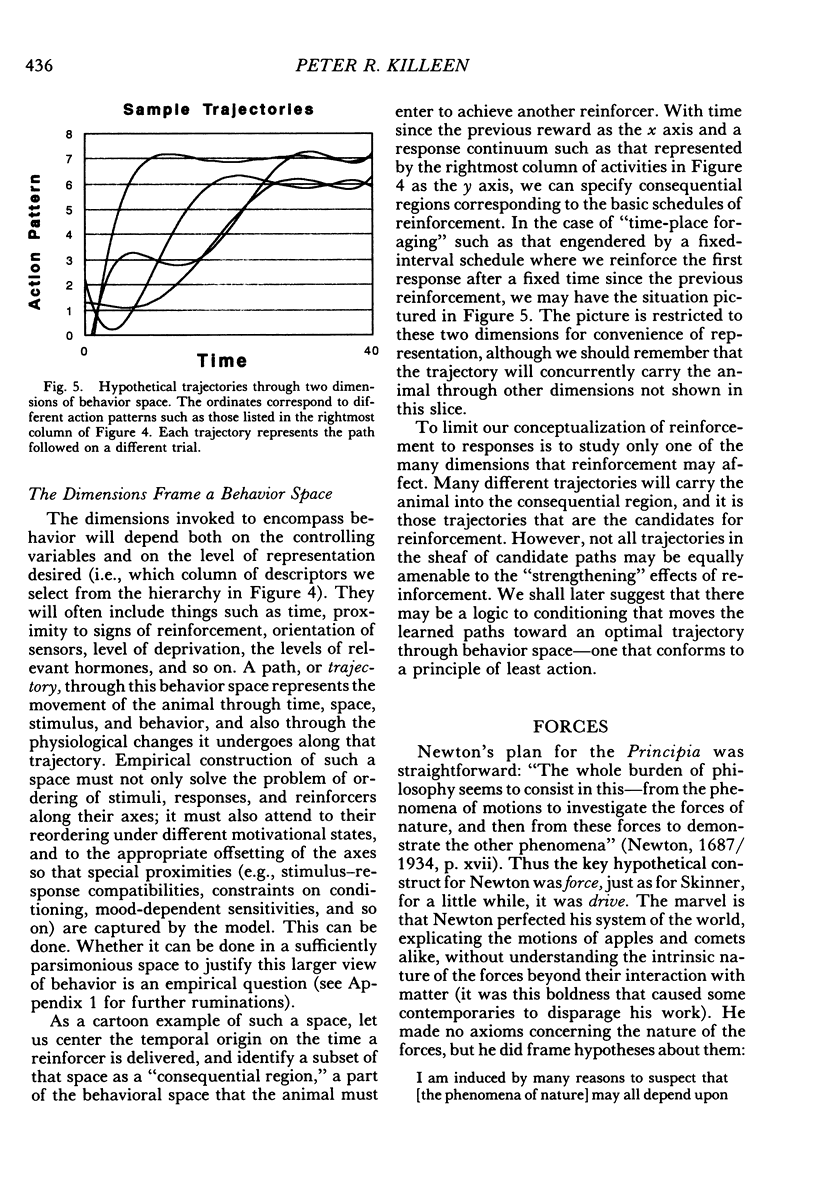
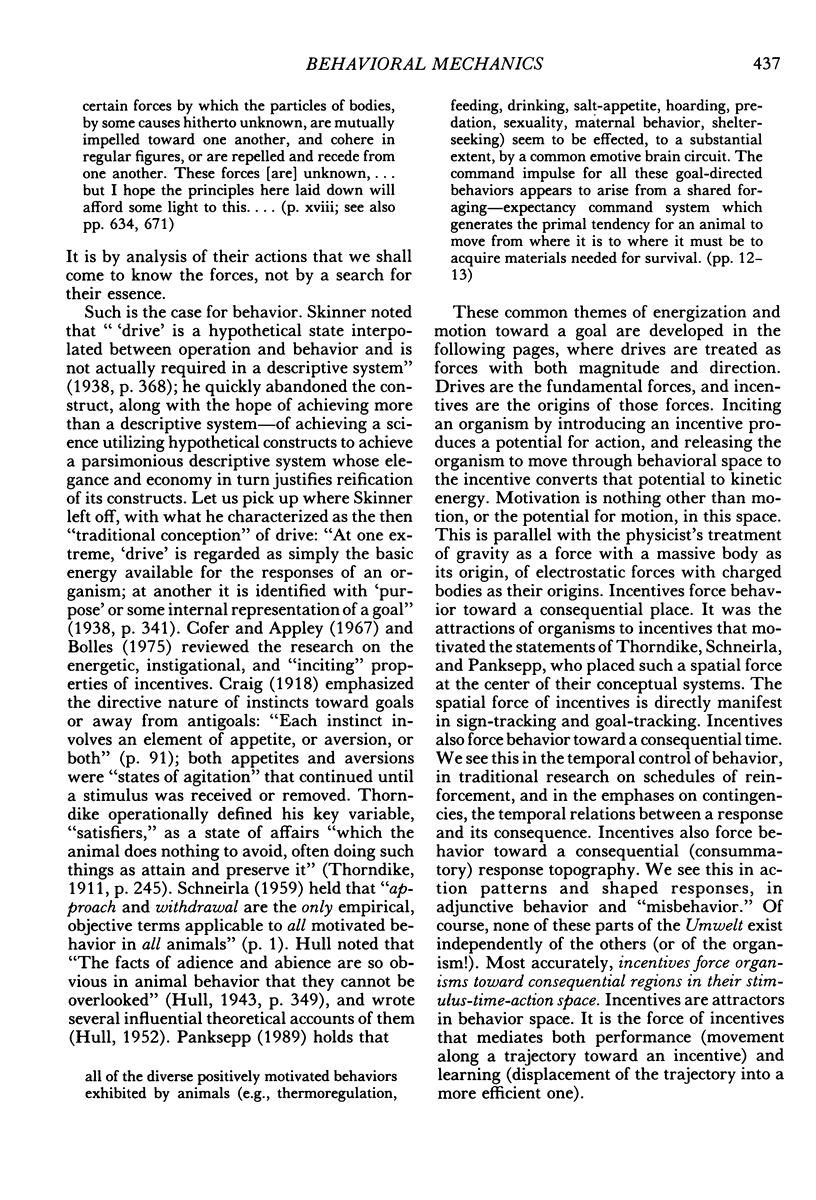
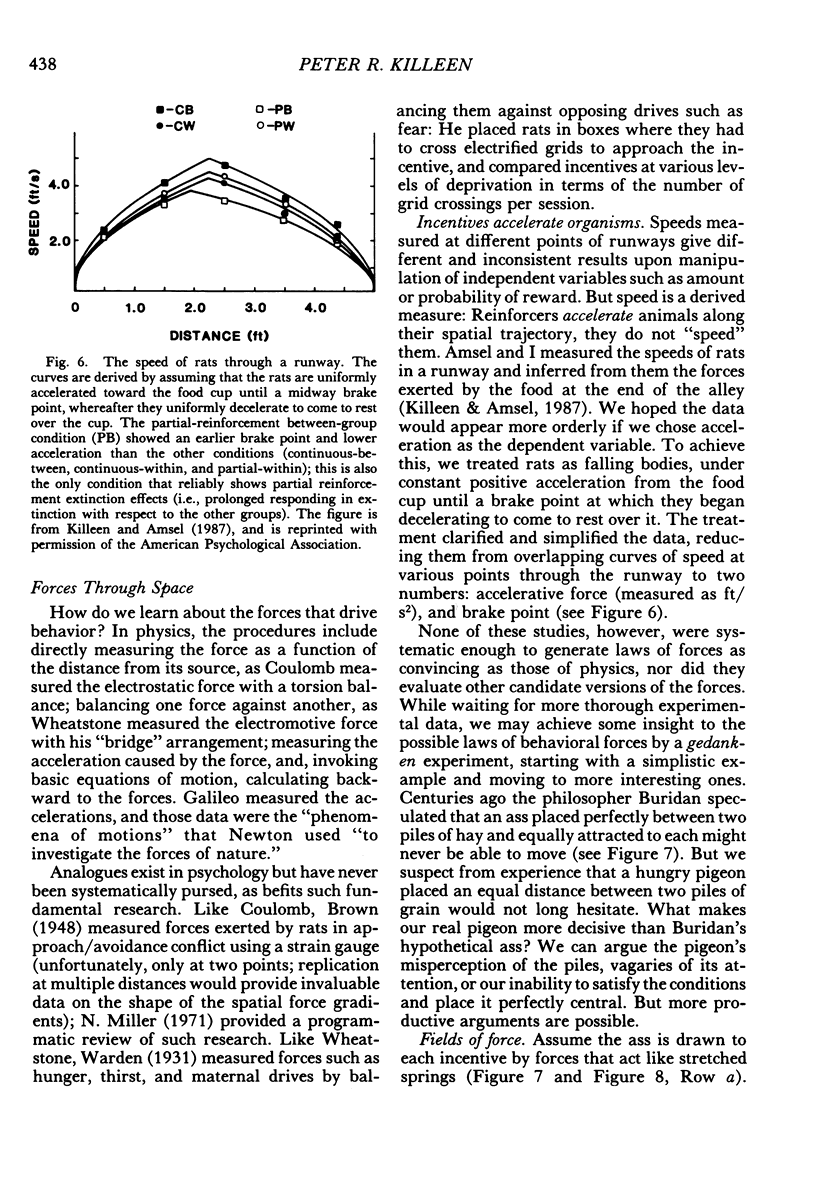
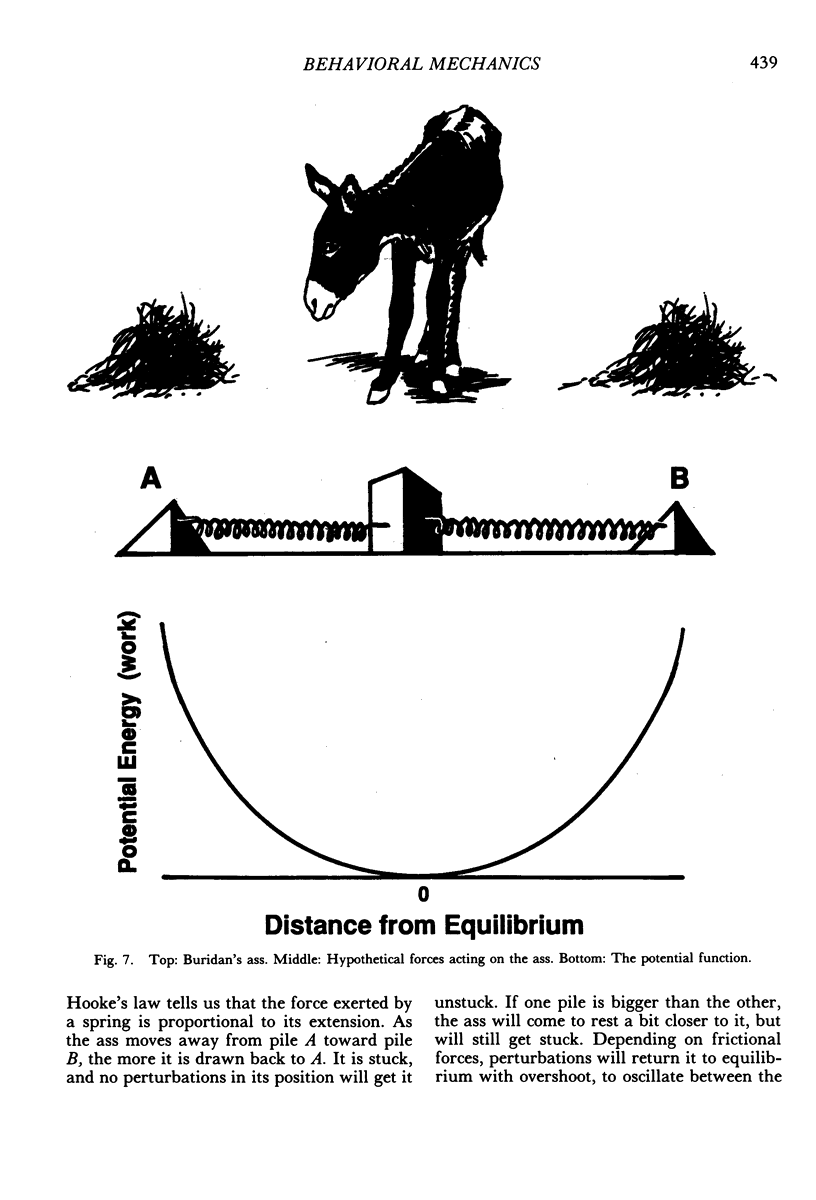
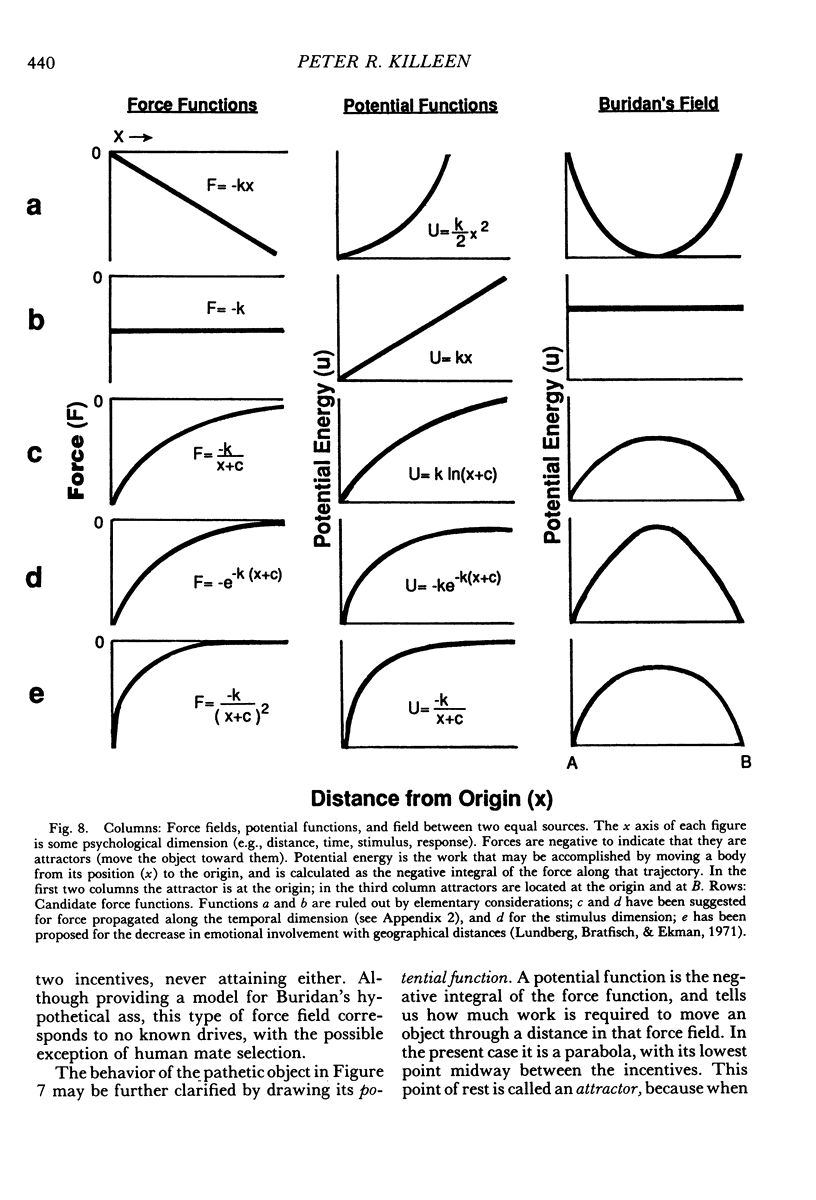
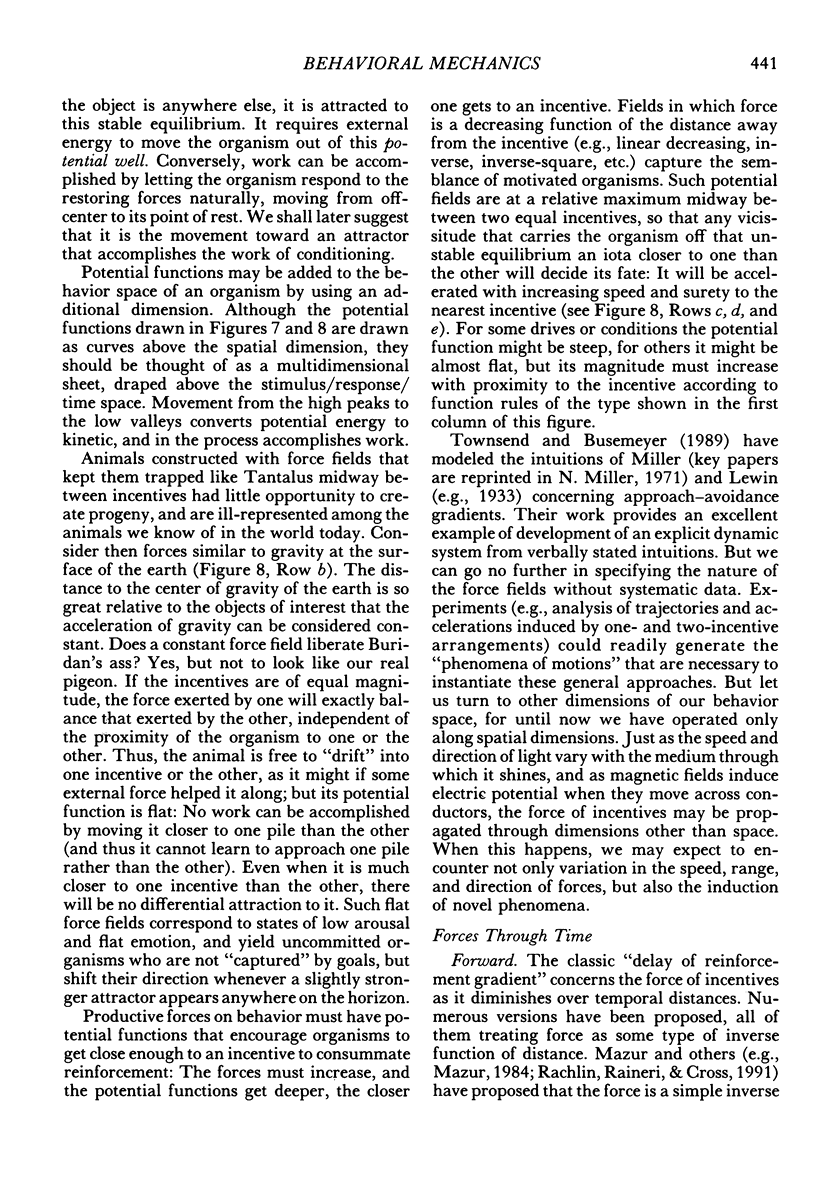
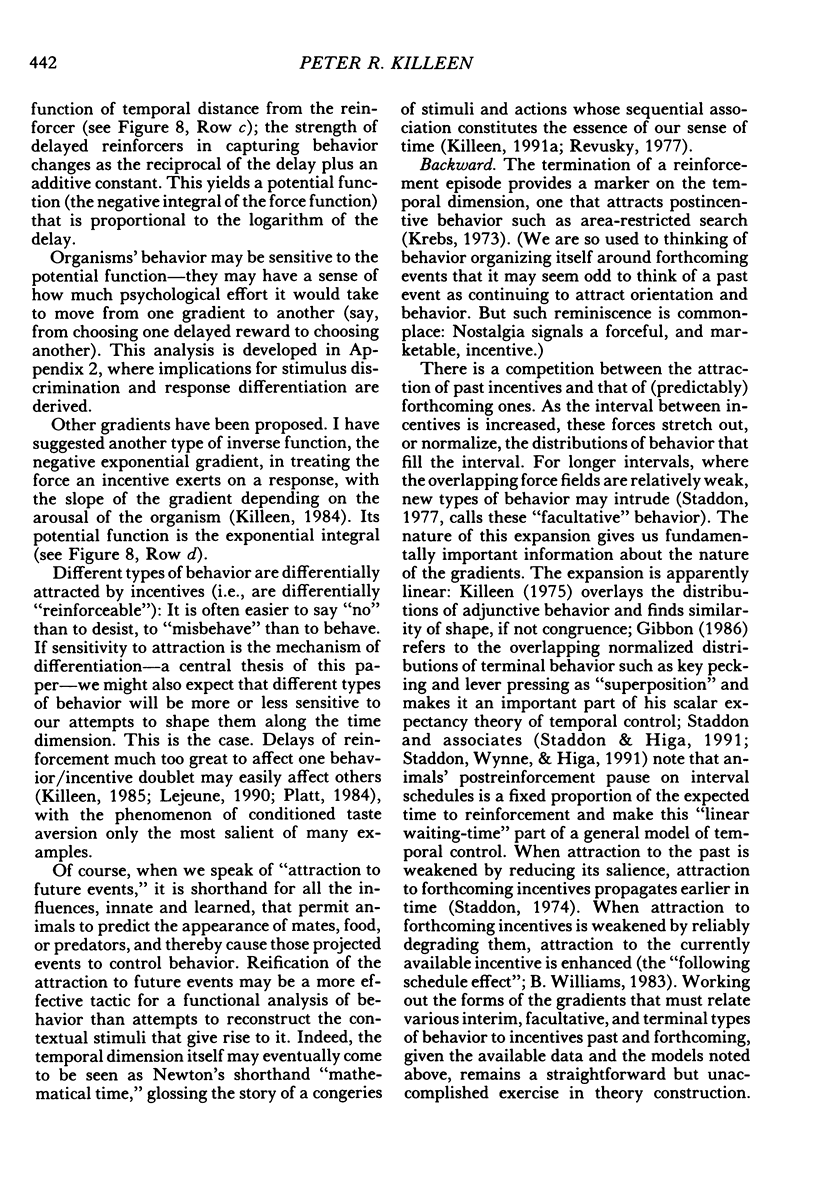
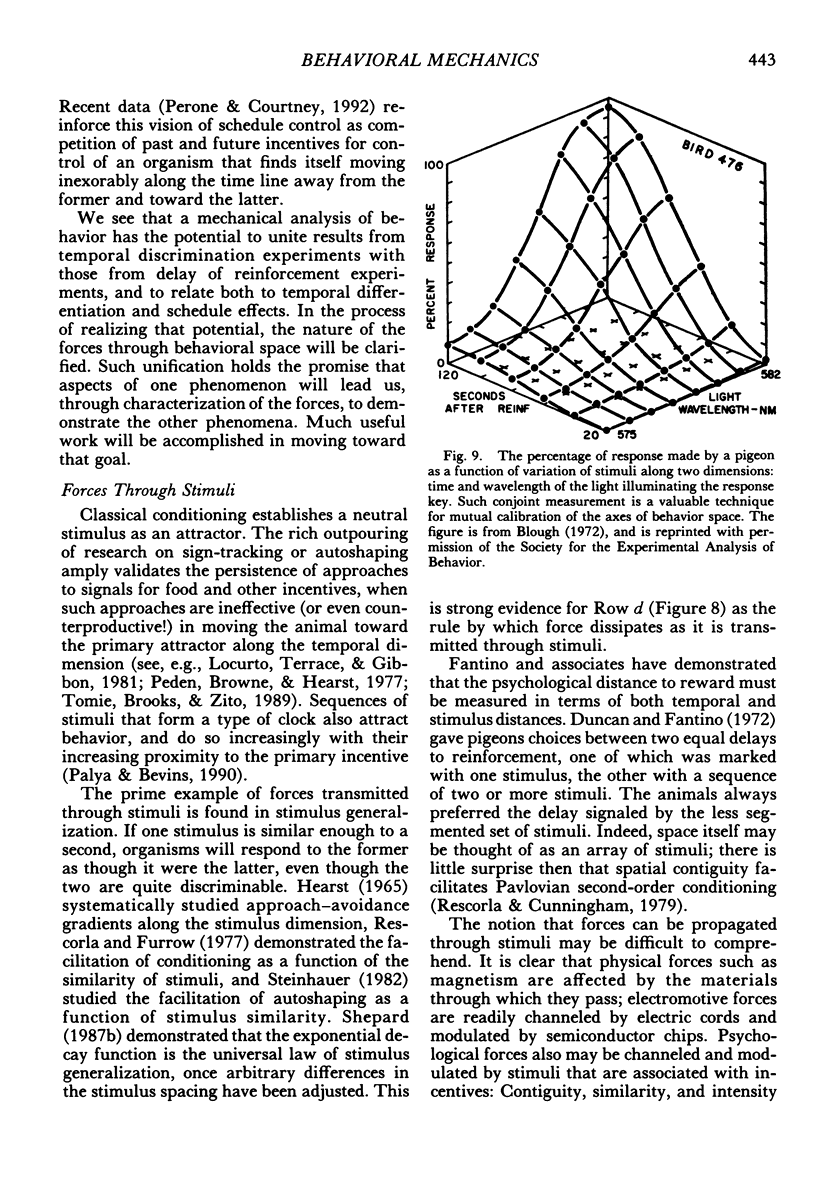
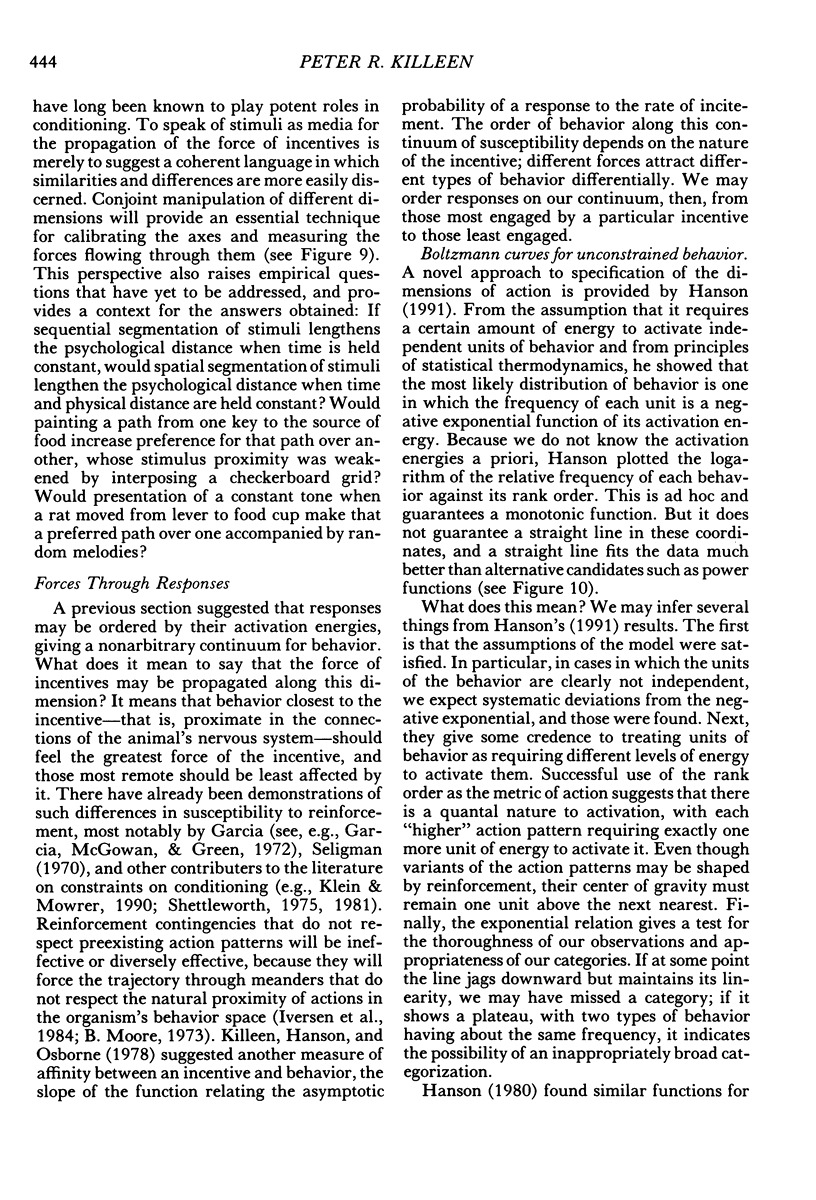
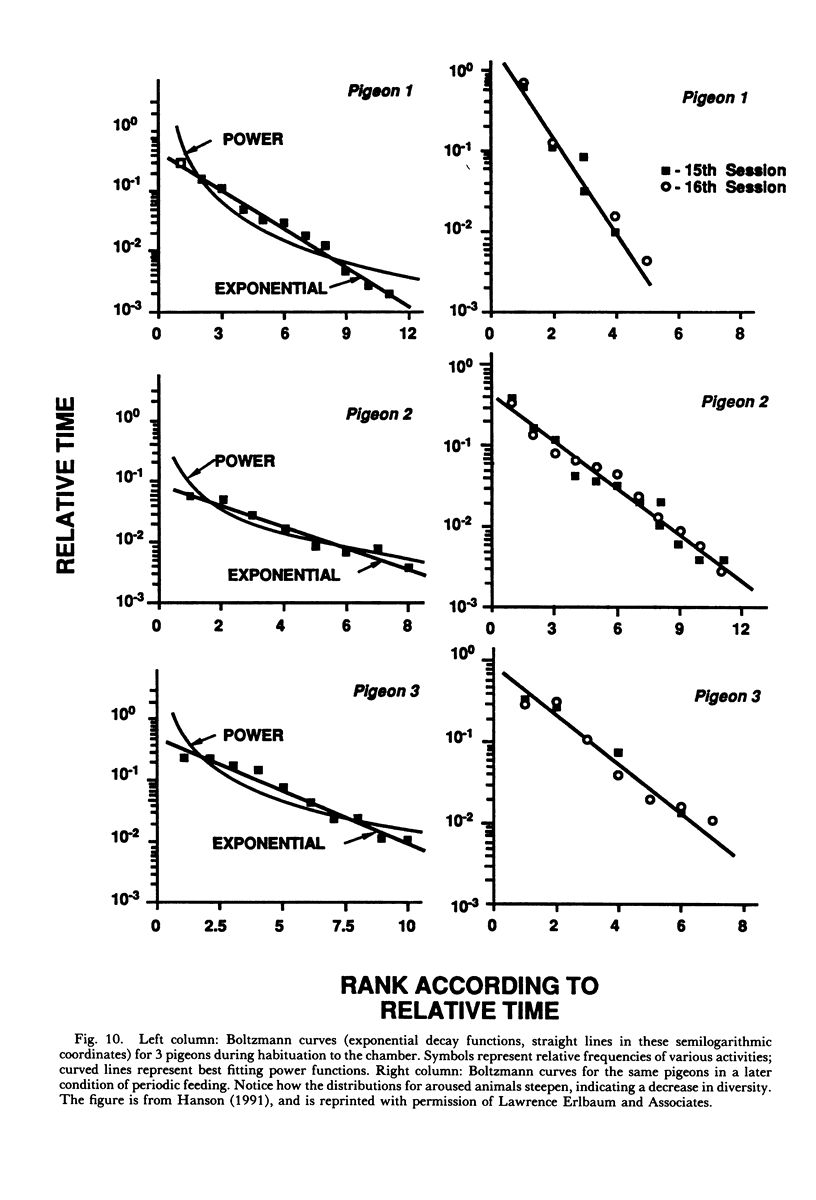
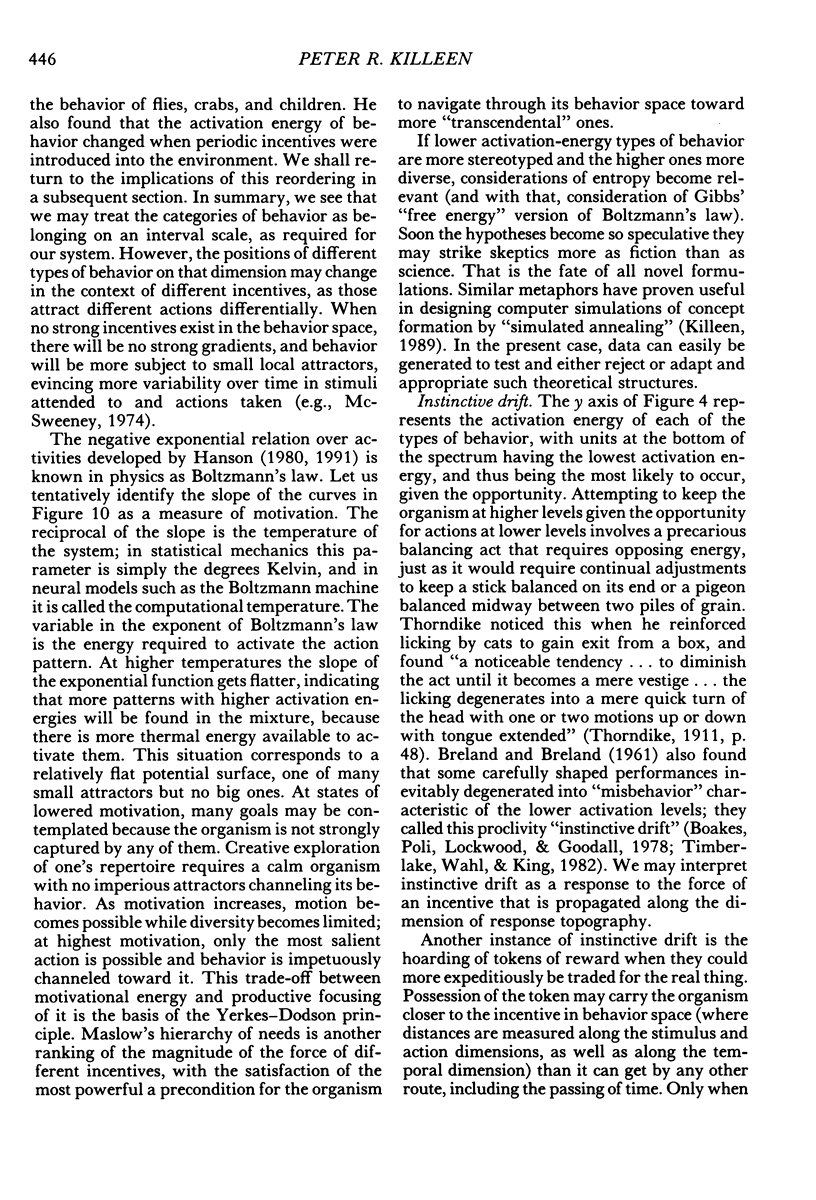
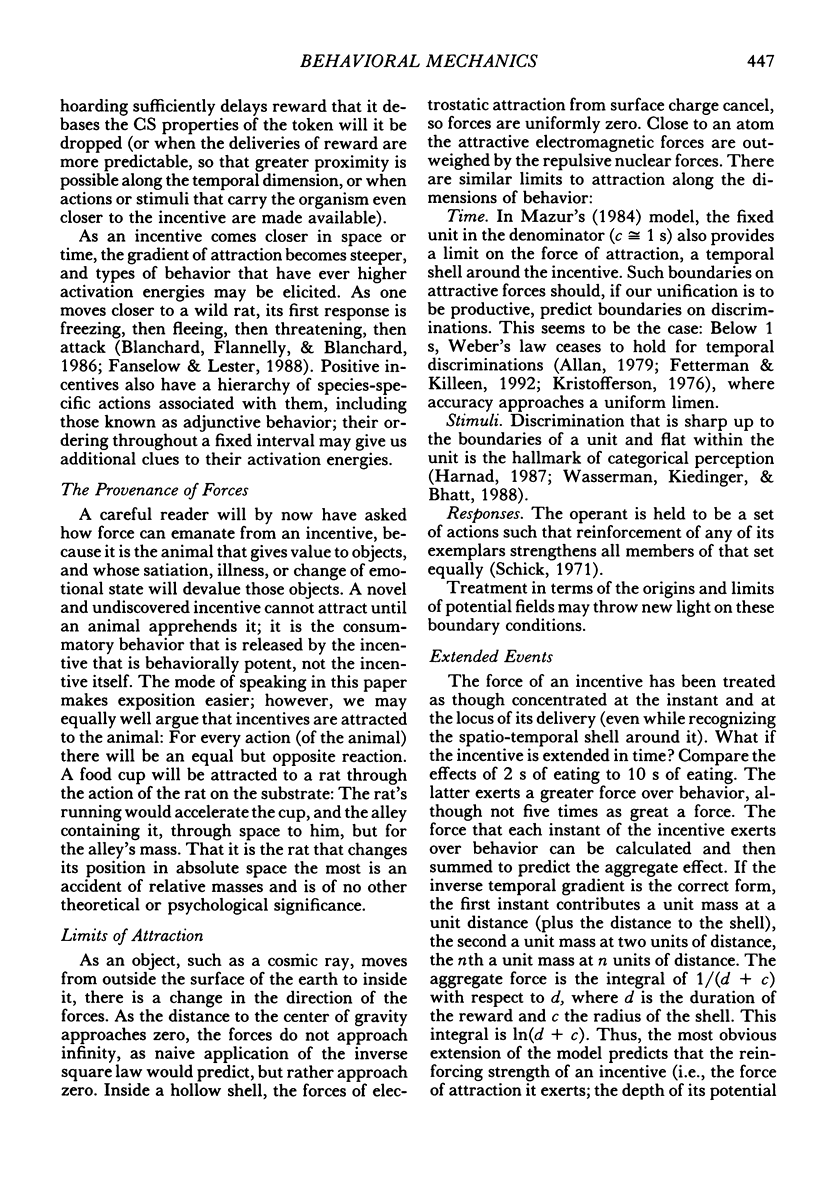
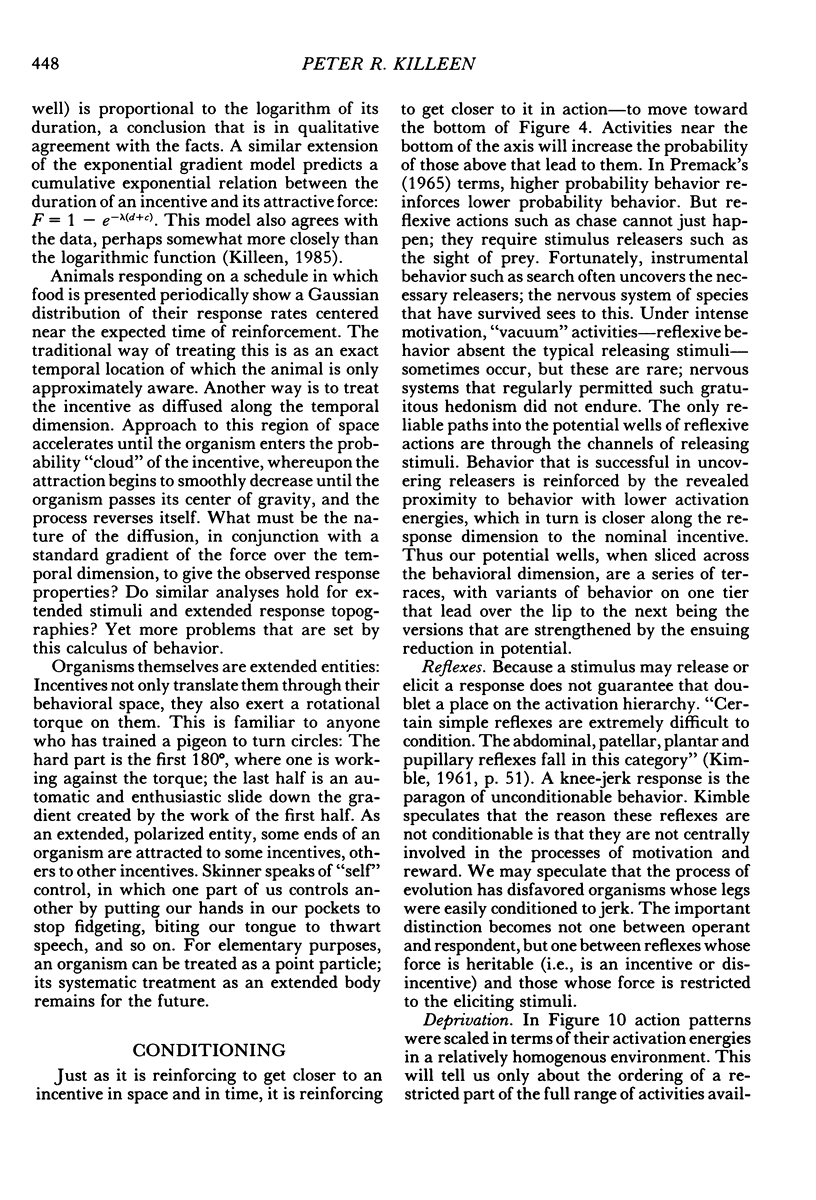
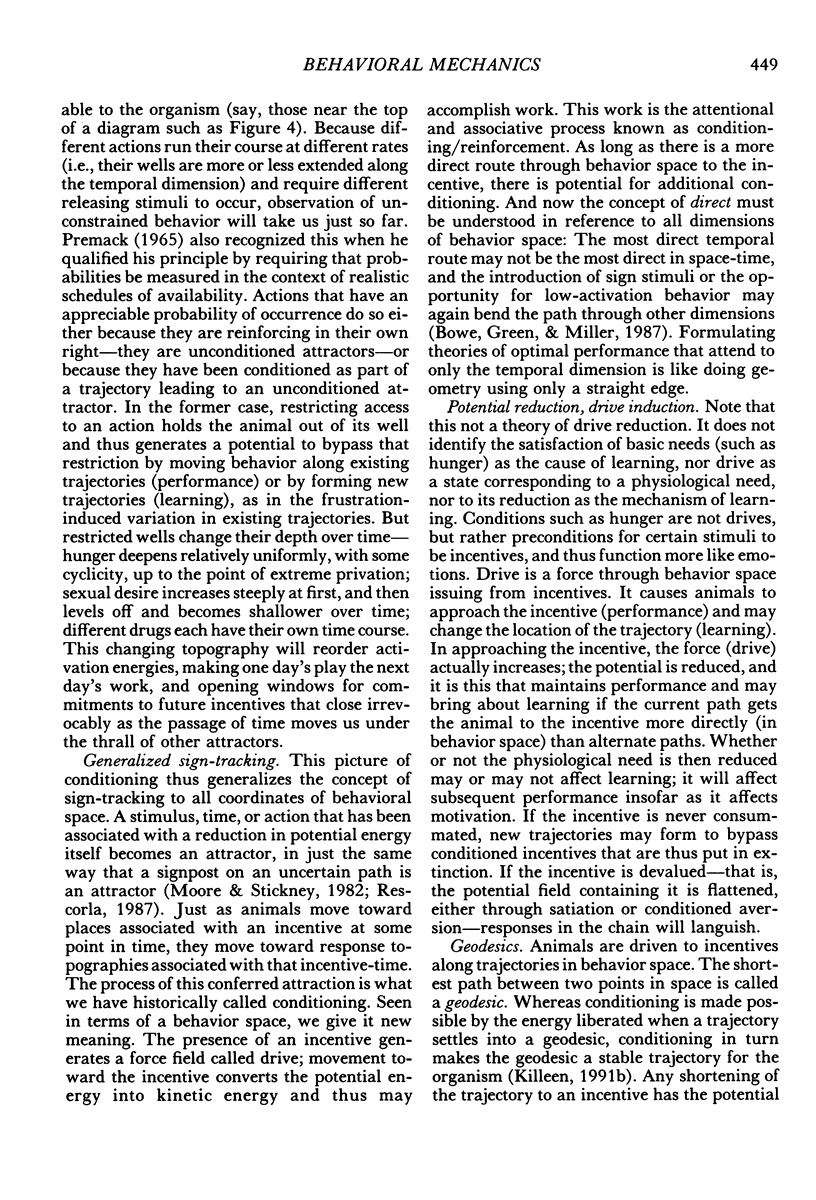
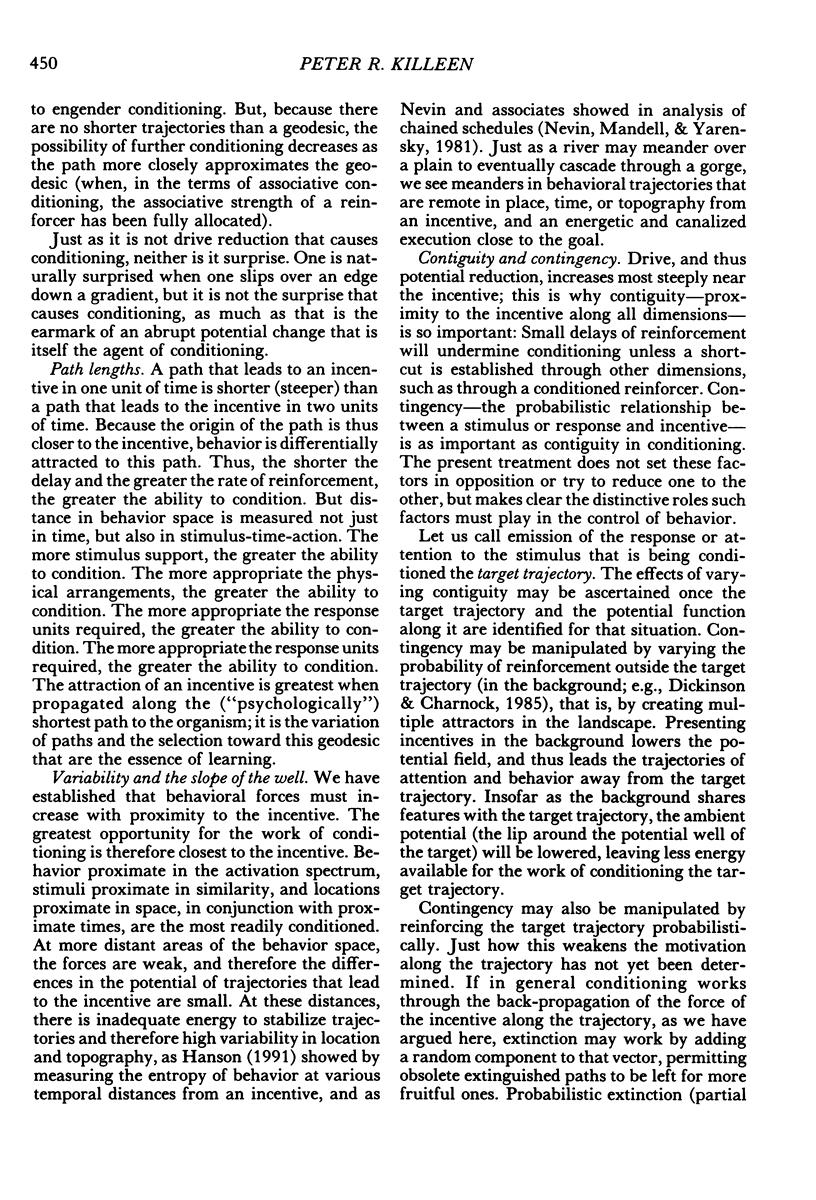
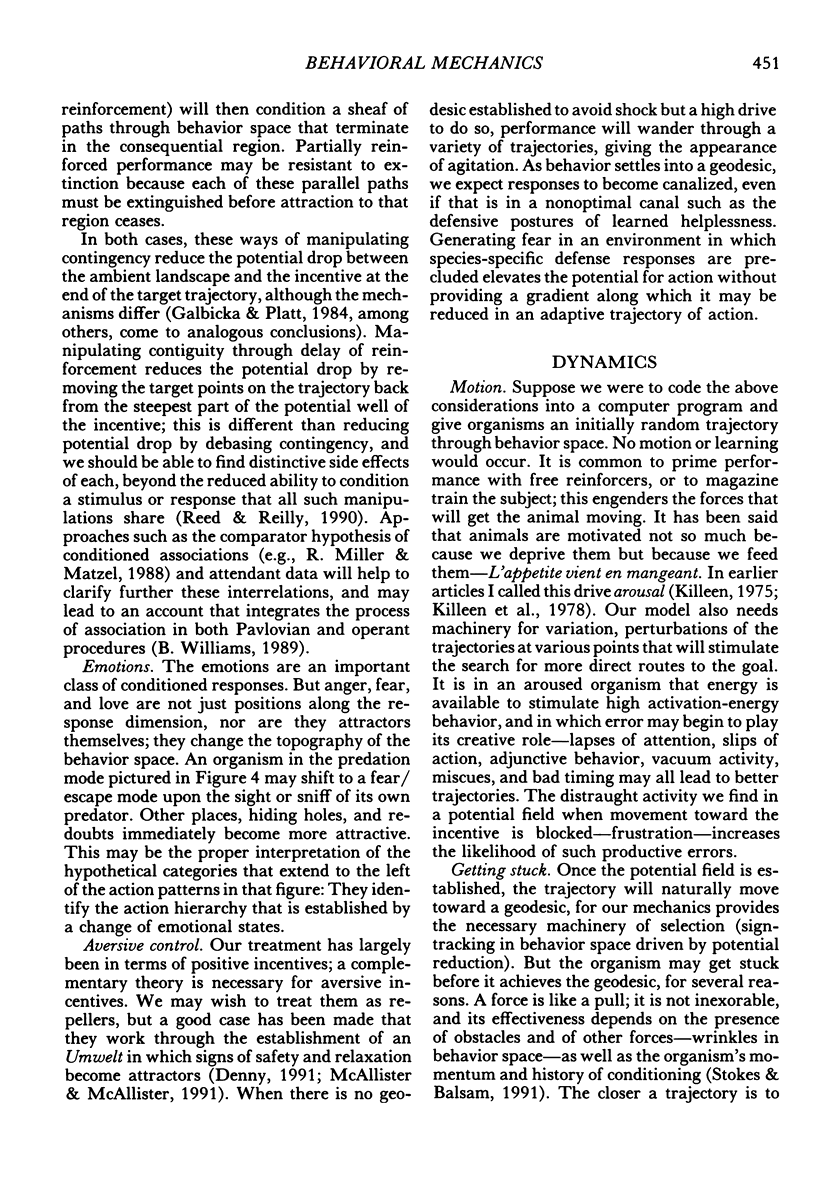
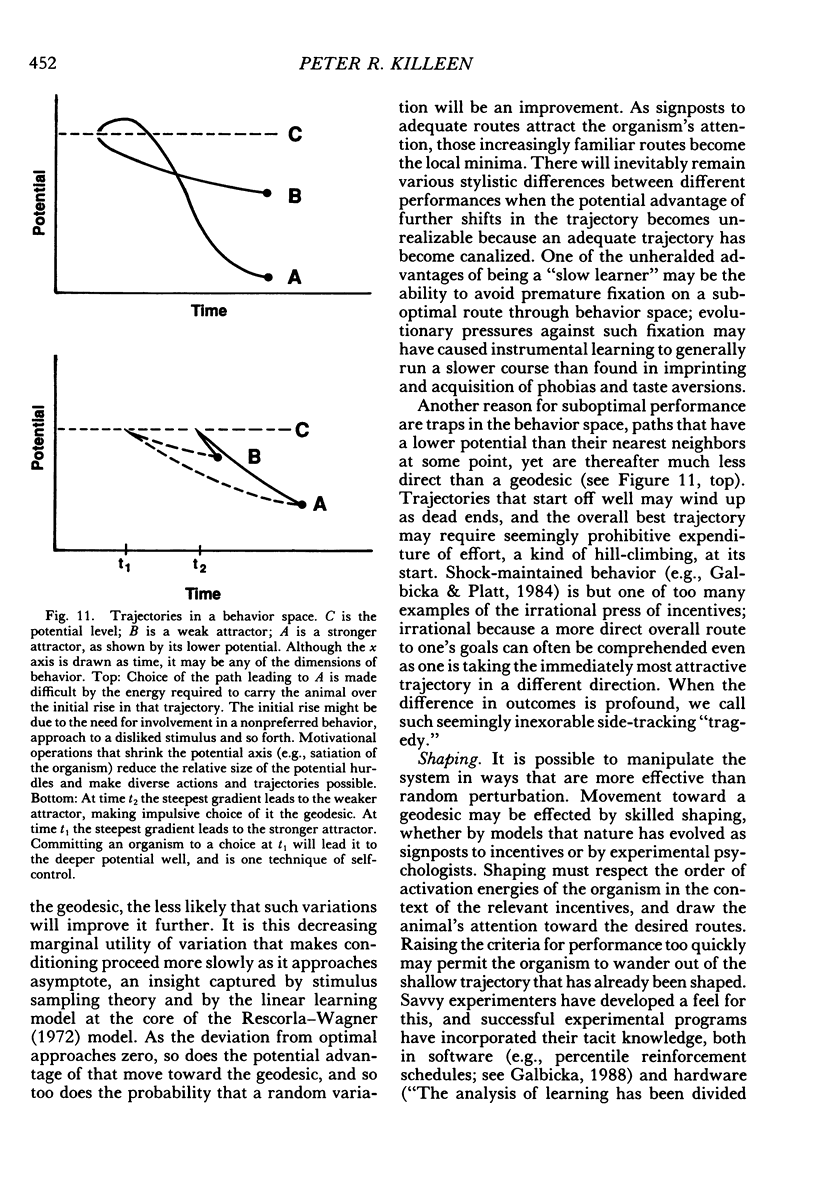
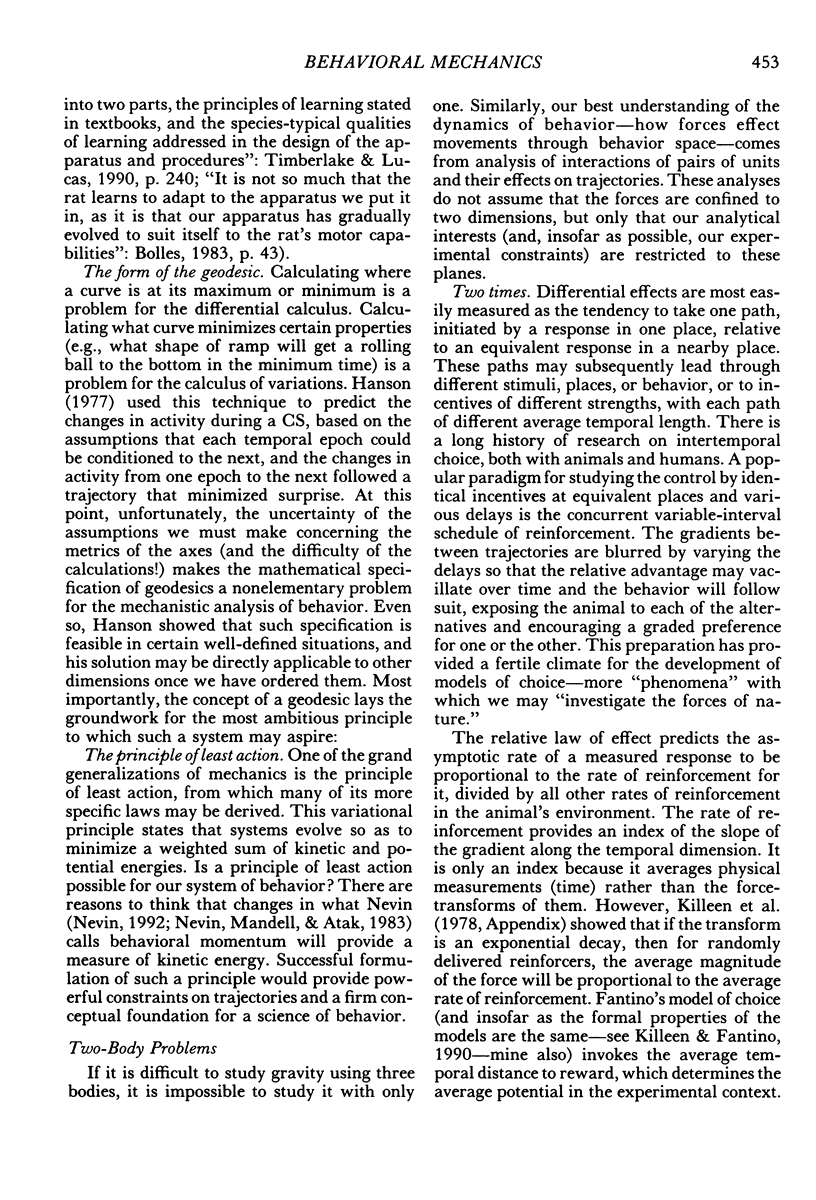
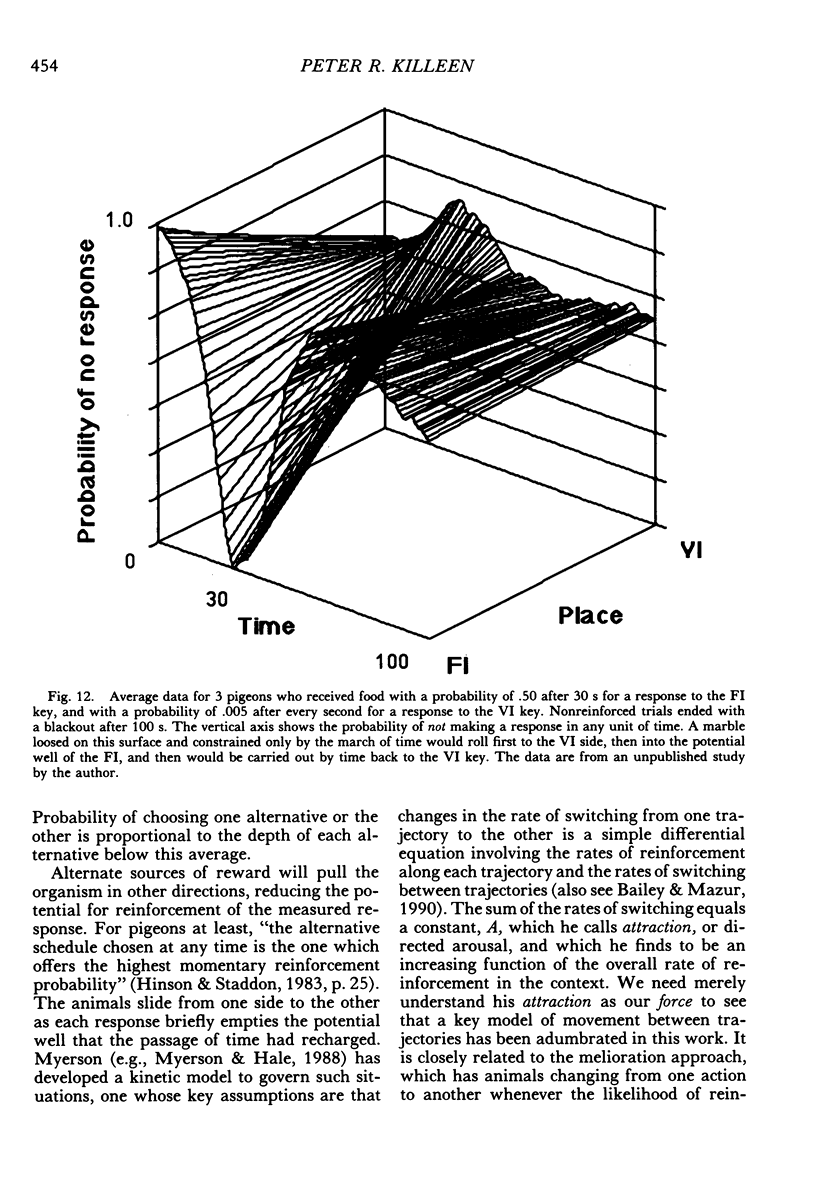
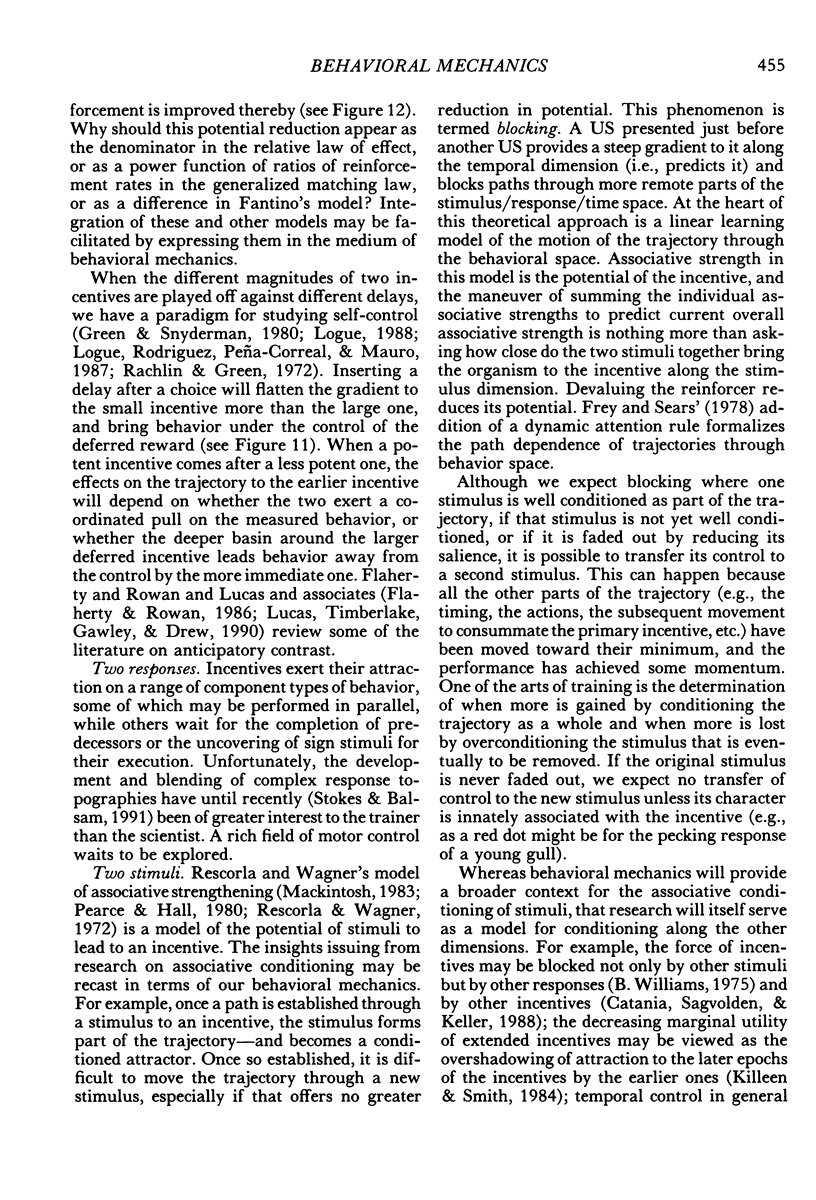
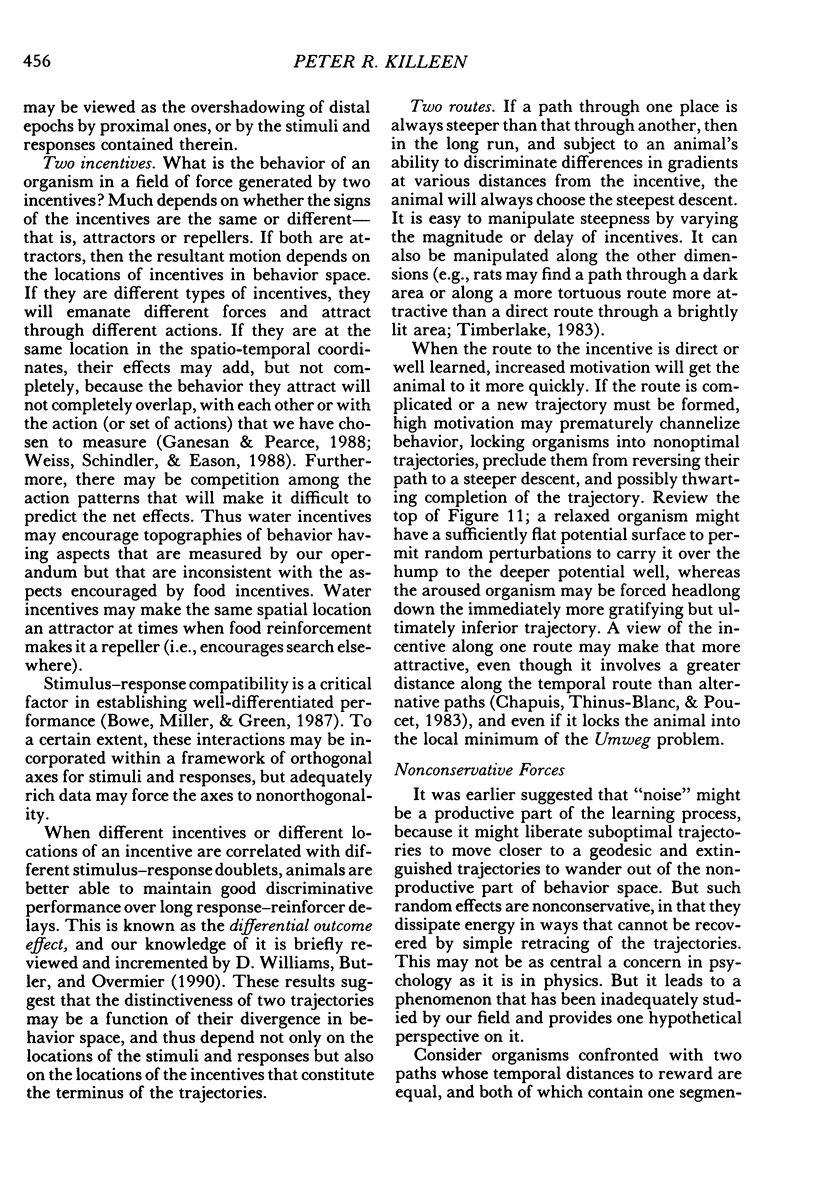

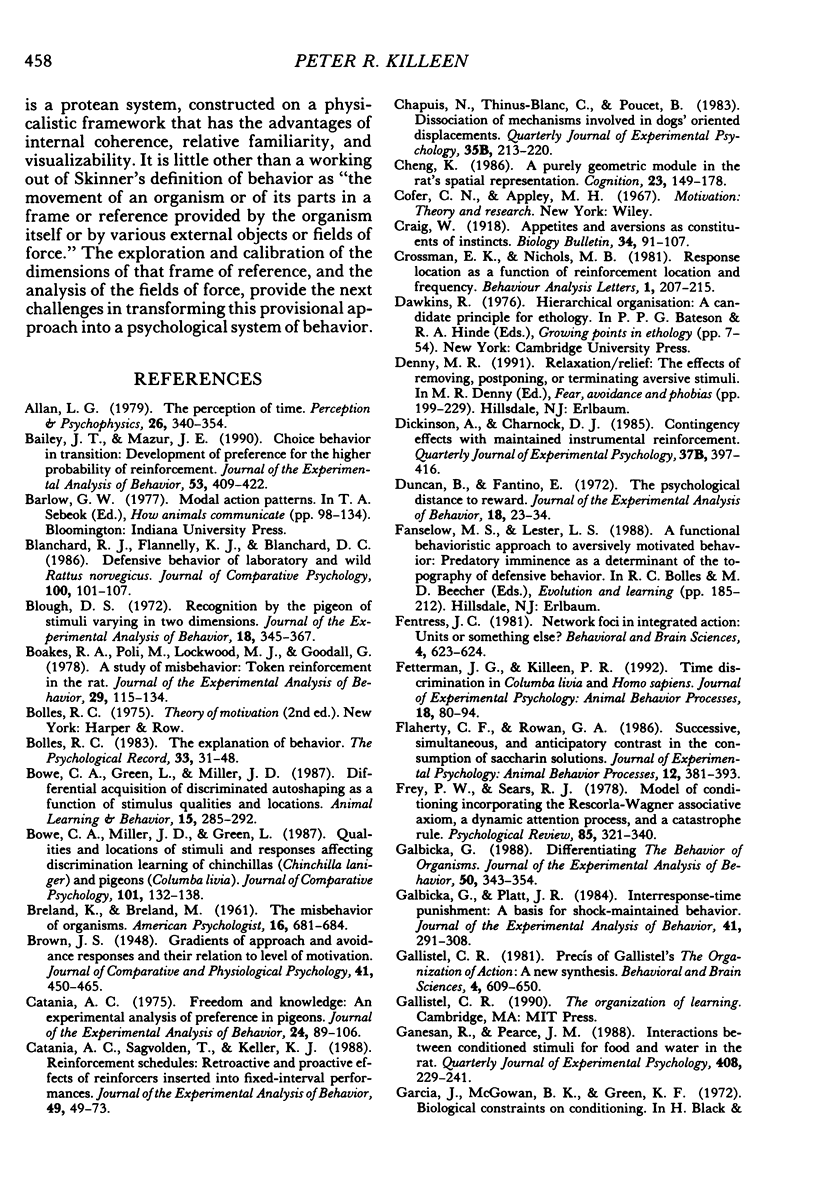
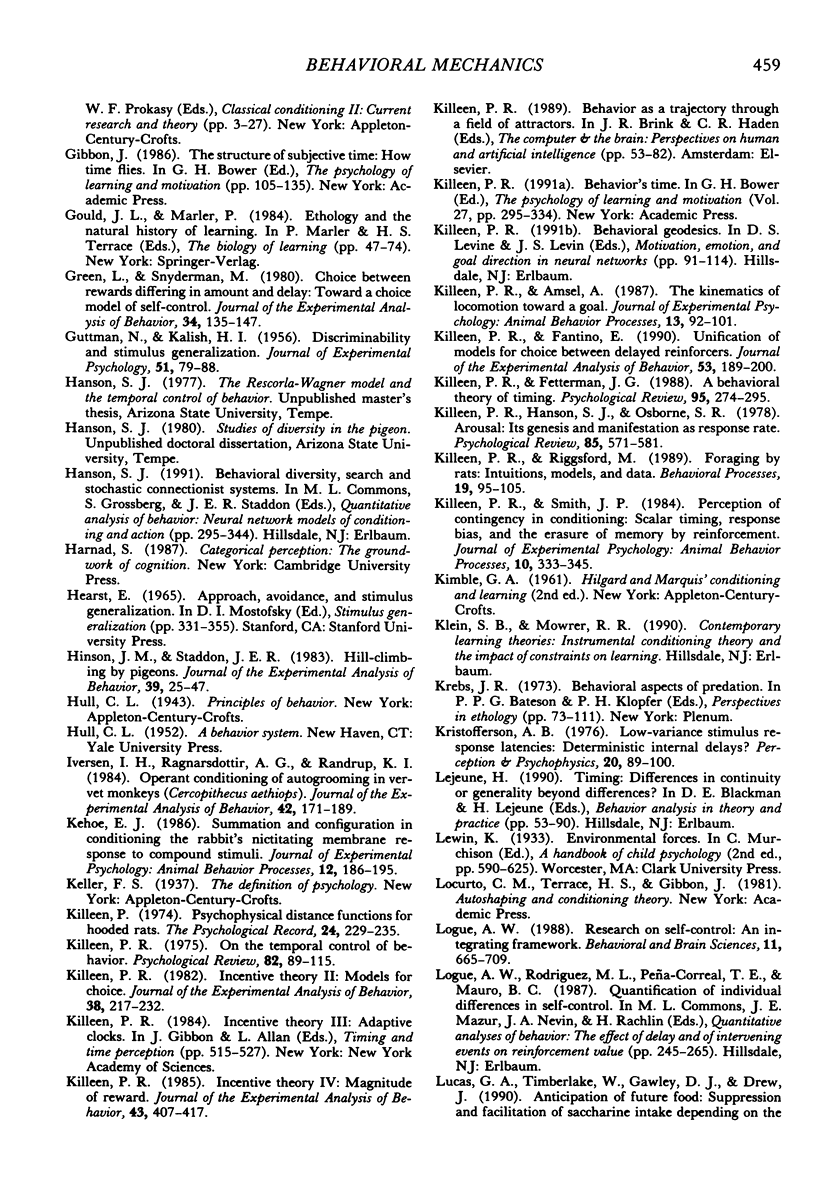
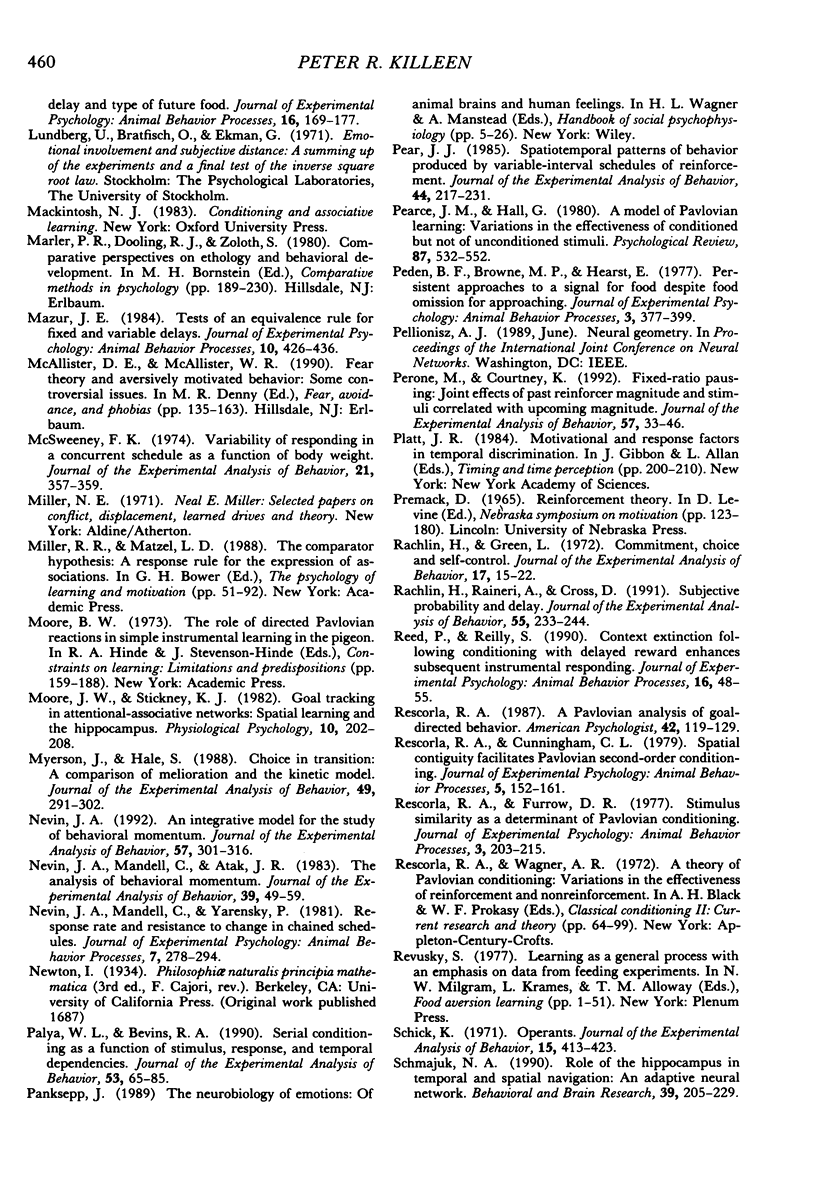
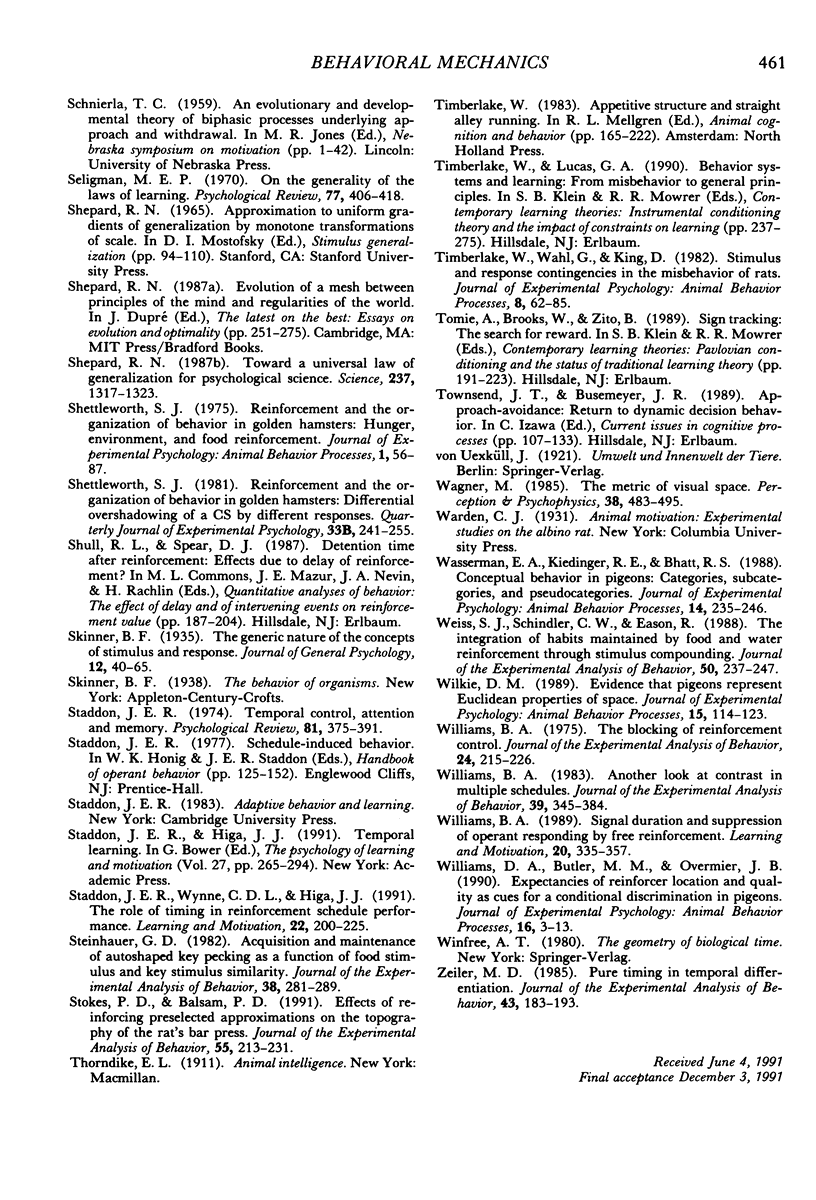
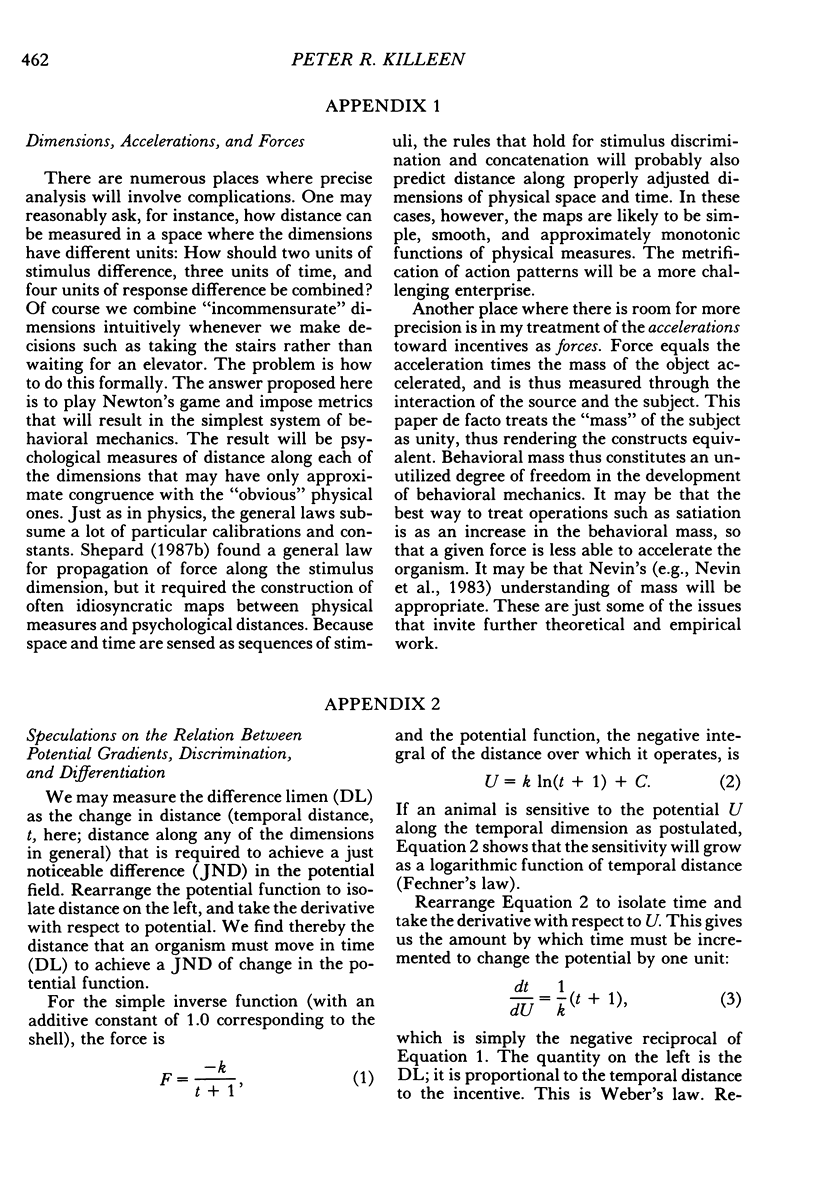
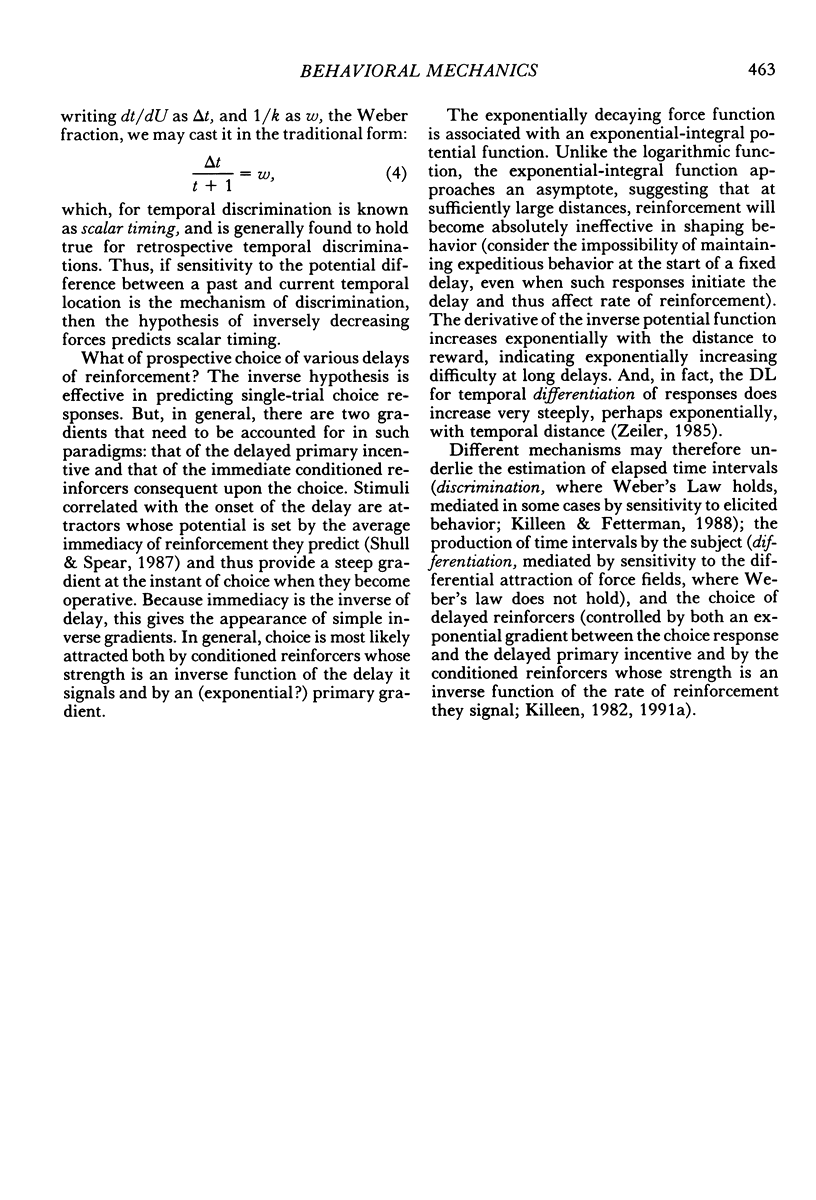
Selected References
These references are in PubMed. This may not be the complete list of references from this article.
- Bailey J. T., Mazur J. E. Choice behavior in transition: development of preference for the higher probability of reinforcement. J Exp Anal Behav. 1990 May;53(3):409–422. doi: 10.1901/jeab.1990.53-409. [DOI] [PMC free article] [PubMed] [Google Scholar]
- Blanchard R. J., Flannelly K. J., Blanchard D. C. Defensive behavior of laboratory and wild Rattus norvegicus. J Comp Psychol. 1986 Jun;100(2):101–107. [PubMed] [Google Scholar]
- Blough D. S. Recognition by the pigeon of stimuli varying in two dimensions. J Exp Anal Behav. 1972 Nov;18(3):345–367. doi: 10.1901/jeab.1972.18-345. [DOI] [PMC free article] [PubMed] [Google Scholar]
- Boakes R. A., Poli M., Lockwood M. J., Goodall G. A study of misbehavior: token reinforcement in the rat. J Exp Anal Behav. 1978 Jan;29(1):115–134. doi: 10.1901/jeab.1978.29-115. [DOI] [PMC free article] [PubMed] [Google Scholar]
- Bowe C. A., Miller J. D., Green L. Qualities and locations of stimuli and responses affecting discrimination learning of chinchillas (Chinchilla laniger) and pigeons (Columba livia). J Comp Psychol. 1987 Jun;101(2):132–138. [PubMed] [Google Scholar]
- Catania A. C. Freedom and knowledge: an experimental analysis of preference in pigeons. J Exp Anal Behav. 1975 Jul;24(1):89–106. doi: 10.1901/jeab.1975.24-89. [DOI] [PMC free article] [PubMed] [Google Scholar]
- Catania A. C., Sagvolden T., Keller K. J. Reinforcement schedules: Retroactive and proactive effects of reinforcers inserted into fixed-interval performances. J Exp Anal Behav. 1988 Jan;49(1):49–73. doi: 10.1901/jeab.1988.49-49. [DOI] [PMC free article] [PubMed] [Google Scholar]
- Chapuis N., Thinus-Blanc C., Poucet B. Dissociation of mechanisms involved in dogs' oriented displacements. Q J Exp Psychol B. 1983 Aug;35(Pt 3):213–219. doi: 10.1080/14640748308400906. [DOI] [PubMed] [Google Scholar]
- Cheng K. A purely geometric module in the rat's spatial representation. Cognition. 1986 Jul;23(2):149–178. doi: 10.1016/0010-0277(86)90041-7. [DOI] [PubMed] [Google Scholar]
- Duncan B., Fantino E. The psychological distance to reward. J Exp Anal Behav. 1972 Jul;18(1):23–34. doi: 10.1901/jeab.1972.18-23. [DOI] [PMC free article] [PubMed] [Google Scholar]
- Fetterman J. G., Killeen P. R. Time discrimination in Columba livia and Homo sapiens. J Exp Psychol Anim Behav Process. 1992 Jan;18(1):80–94. doi: 10.1037//0097-7403.18.1.80. [DOI] [PubMed] [Google Scholar]
- Flaherty C. F., Rowan G. A. Successive, simultaneous, and anticipatory contrast in the consumption of saccharin solutions. J Exp Psychol Anim Behav Process. 1986 Oct;12(4):381–393. [PubMed] [Google Scholar]
- GUTTMAN N., KALISH H. I. Discriminability and stimulus generalization. J Exp Psychol. 1956 Jan;51(1):79–88. doi: 10.1037/h0046219. [DOI] [PubMed] [Google Scholar]
- Galbicka G. Differentiating the behavior of organisms. J Exp Anal Behav. 1988 Sep;50(2):343–354. doi: 10.1901/jeab.1988.50-343. [DOI] [PMC free article] [PubMed] [Google Scholar]
- Galbicka G., Platt J. R. Interresponse-time punishment: a basis for shock-maintained behavior. J Exp Anal Behav. 1984 May;41(3):291–308. doi: 10.1901/jeab.1984.41-291. [DOI] [PMC free article] [PubMed] [Google Scholar]
- Ganesan R., Pearce J. M. Interactions between conditioned stimuli for food and water in the rat. Q J Exp Psychol B. 1988 Aug;40(3):229–241. [PubMed] [Google Scholar]
- Green L., Snyderman M. Choice between rewards differing in amount and delay: Toward a choice model of self control. J Exp Anal Behav. 1980 Sep;34(2):135–147. doi: 10.1901/jeab.1980.34-135. [DOI] [PMC free article] [PubMed] [Google Scholar]
- Hinson J. M., Staddon J. E. Hill-climbing by pigeons. J Exp Anal Behav. 1983 Jan;39(1):25–47. doi: 10.1901/jeab.1983.39-25. [DOI] [PMC free article] [PubMed] [Google Scholar]
- Iversen I. H., Ragnarsdottir G. A., Randrup K. I. Operant conditioning of autogrooming in vervet monkeys: Cercopithecus aethiops. J Exp Anal Behav. 1984 Sep;42(2):171–189. doi: 10.1901/jeab.1984.42-171. [DOI] [PMC free article] [PubMed] [Google Scholar]
- Killeen P. R., Amsel A. The kinematics of locomotion toward a goal. J Exp Psychol Anim Behav Process. 1987 Jan;13(1):92–101. [PubMed] [Google Scholar]
- Killeen P. R., Fantino E. Unification of models for choice between delayed reinforcers. J Exp Anal Behav. 1990 Jan;53(1):189–200. doi: 10.1901/jeab.1990.53-189. [DOI] [PMC free article] [PubMed] [Google Scholar]
- Killeen P. R., Fetterman J. G. A behavioral theory of timing. Psychol Rev. 1988 Apr;95(2):274–295. doi: 10.1037/0033-295x.95.2.274. [DOI] [PubMed] [Google Scholar]
- Killeen P. R., Hanson S. J., Osborne S. R. Arousal: its genesis and manifestation as response rate. Psychol Rev. 1978 Nov;85(6):571–581. [PubMed] [Google Scholar]
- Killeen P. R. Incentive theory: II. Models for choice. J Exp Anal Behav. 1982 Sep;38(2):217–232. doi: 10.1901/jeab.1982.38-217. [DOI] [PMC free article] [PubMed] [Google Scholar]
- Killeen P. R. Incentive theory: IV. Magnitude of reward. J Exp Anal Behav. 1985 May;43(3):407–417. doi: 10.1901/jeab.1985.43-407. [DOI] [PMC free article] [PubMed] [Google Scholar]
- McSweeney F. K. Variability of responding on a concurrent schedule as a function of body weight. J Exp Anal Behav. 1974 Mar;21(2):357–359. doi: 10.1901/jeab.1974.21-357. [DOI] [PMC free article] [PubMed] [Google Scholar]
- Myerson J., Hale S. Choice in transition: A comparison of melioration and the kinetic model. J Exp Anal Behav. 1988 Mar;49(2):291–302. doi: 10.1901/jeab.1988.49-291. [DOI] [PMC free article] [PubMed] [Google Scholar]
- Nevin J. A. An integrative model for the study of behavioral momentum. J Exp Anal Behav. 1992 May;57(3):301–316. doi: 10.1901/jeab.1992.57-301. [DOI] [PMC free article] [PubMed] [Google Scholar]
- Nevin J. A., Mandell C., Atak J. R. The analysis of behavioral momentum. J Exp Anal Behav. 1983 Jan;39(1):49–59. doi: 10.1901/jeab.1983.39-49. [DOI] [PMC free article] [PubMed] [Google Scholar]
- Palya W. L., Bevins R. A. Serial conditioning as a function of stimulus, response, and temporal dependencies. J Exp Anal Behav. 1990 Jan;53(1):65–85. doi: 10.1901/jeab.1990.53-65. [DOI] [PMC free article] [PubMed] [Google Scholar]
- Pear J. J. Spatiotemporal patterns of behavior produced by variable-interval schedules of reinforcement. J Exp Anal Behav. 1985 Sep;44(2):217–231. doi: 10.1901/jeab.1985.44-217. [DOI] [PMC free article] [PubMed] [Google Scholar]
- Pearce J. M., Hall G. A model for Pavlovian learning: variations in the effectiveness of conditioned but not of unconditioned stimuli. Psychol Rev. 1980 Nov;87(6):532–552. [PubMed] [Google Scholar]
- Perone M., Courtney K. Fixed-ratio pausing: Joint effects of past reinforcer magnitude and stimuli correlated with upcoming magnitude. J Exp Anal Behav. 1992 Jan;57(1):33–46. doi: 10.1901/jeab.1992.57-33. [DOI] [PMC free article] [PubMed] [Google Scholar]
- Rachlin H., Green L. Commitment, choice and self-control. J Exp Anal Behav. 1972 Jan;17(1):15–22. doi: 10.1901/jeab.1972.17-15. [DOI] [PMC free article] [PubMed] [Google Scholar]
- Rachlin H., Raineri A., Cross D. Subjective probability and delay. J Exp Anal Behav. 1991 Mar;55(2):233–244. doi: 10.1901/jeab.1991.55-233. [DOI] [PMC free article] [PubMed] [Google Scholar]
- Reed P., Reilly S. Context extinction following conditioning with delayed reward enhances subsequent instrumental responding. J Exp Psychol Anim Behav Process. 1990 Jan;16(1):48–55. [PubMed] [Google Scholar]
- Rescorla R. A., Cunningham C. L. Spatial contiguity facilitates Pavlovian second-order conditioning. J Exp Psychol Anim Behav Process. 1979 Apr;5(2):152–161. doi: 10.1037//0097-7403.5.2.152. [DOI] [PubMed] [Google Scholar]
- Rescorla R. A., Furrow D. R. Stimulus similarity as a determinant of Pavlovian conditioning. J Exp Psychol Anim Behav Process. 1977 Jul;3(3):203–215. doi: 10.1037//0097-7403.3.3.203. [DOI] [PubMed] [Google Scholar]
- Schick K. Operants. J Exp Anal Behav. 1971 May;15(3):413–423. doi: 10.1901/jeab.1971.15-413. [DOI] [PMC free article] [PubMed] [Google Scholar]
- Schmajuk N. A. Role of the hippocampus in temporal and spatial navigation: an adaptive neural network. Behav Brain Res. 1990 Aug 20;39(3):205–229. doi: 10.1016/0166-4328(90)90028-d. [DOI] [PubMed] [Google Scholar]
- Shepard R. N. Toward a universal law of generalization for psychological science. Science. 1987 Sep 11;237(4820):1317–1323. doi: 10.1126/science.3629243. [DOI] [PubMed] [Google Scholar]
- Steinhauer G. D. Acquisition and maintenance of autoshaped key pecking as a function of food stimulus and key stimulus similarity. J Exp Anal Behav. 1982 Nov;38(3):281–289. doi: 10.1901/jeab.1982.38-281. [DOI] [PMC free article] [PubMed] [Google Scholar]
- Stokes P. D., Balsam P. D. Effects of reinforcing preselected approximations on the topography of the rat's bar press. J Exp Anal Behav. 1991 Mar;55(2):213–231. doi: 10.1901/jeab.1991.55-213. [DOI] [PMC free article] [PubMed] [Google Scholar]
- Timberlake W., Wahl G., King D. Stimulus and response contingencies in the misbehavior of rats. J Exp Psychol Anim Behav Process. 1982 Jan;8(1):62–85. [PubMed] [Google Scholar]
- Wagner M. The metric of visual space. Percept Psychophys. 1985 Dec;38(6):483–495. doi: 10.3758/bf03207058. [DOI] [PubMed] [Google Scholar]
- Weiss S. J., Schindler C. W., Eason R. The integration of habits maintained by food and water reinforcement through stimulus compounding. J Exp Anal Behav. 1988 Sep;50(2):237–247. doi: 10.1901/jeab.1988.50-237. [DOI] [PMC free article] [PubMed] [Google Scholar]
- Williams B. A. Another look at contrast in multiple schedules. J Exp Anal Behav. 1983 Mar;39(2):345–384. doi: 10.1901/jeab.1983.39-345. [DOI] [PMC free article] [PubMed] [Google Scholar]
- Williams B. A. The blocking of reinforcement control. J Exp Anal Behav. 1975 Sep;24(2):215–225. doi: 10.1901/jeab.1975.24-215. [DOI] [PMC free article] [PubMed] [Google Scholar]
- Williams D. A., Butler M. M., Overmier J. B. Expectancies of reinforcer location and quality as cues for a conditional discrimination in pigeons. J Exp Psychol Anim Behav Process. 1990 Jan;16(1):3–13. [PubMed] [Google Scholar]
- Zeiler M. D. Pure timing in temporal differentiation. J Exp Anal Behav. 1985 Mar;43(2):183–193. doi: 10.1901/jeab.1985.43-183. [DOI] [PMC free article] [PubMed] [Google Scholar]


